Get PeakVisor App
Sign In
Search by GPS coordinates
- Latitude
- ° ' ''
- Longitude
- ° ' ''
- Units of Length
- Temperature

Yes
Cancel
Share ×

Scan the QR code and open PeakVisor on your phone
❤ Wishlist ×
Choose
Delete
Ski Arlberg is the largest ski area in Austria and one of the largest in the world. It sprawls across several mountains in the western Vorarlberg and Tyrol regions, offering something for everyone. Ski Arlberg’s main feature is its size. Skiers can spread across 85 lifts and cable cars, 300 km (186 mi) of pistes, and countless off-piste routes. Arlberg’s massive size makes it challenging to measure in terms of hectares, but it is undoubtedly one of Europe’s largest ski resorts, with hundreds of named runs. The season ranges from early December through mid-April.
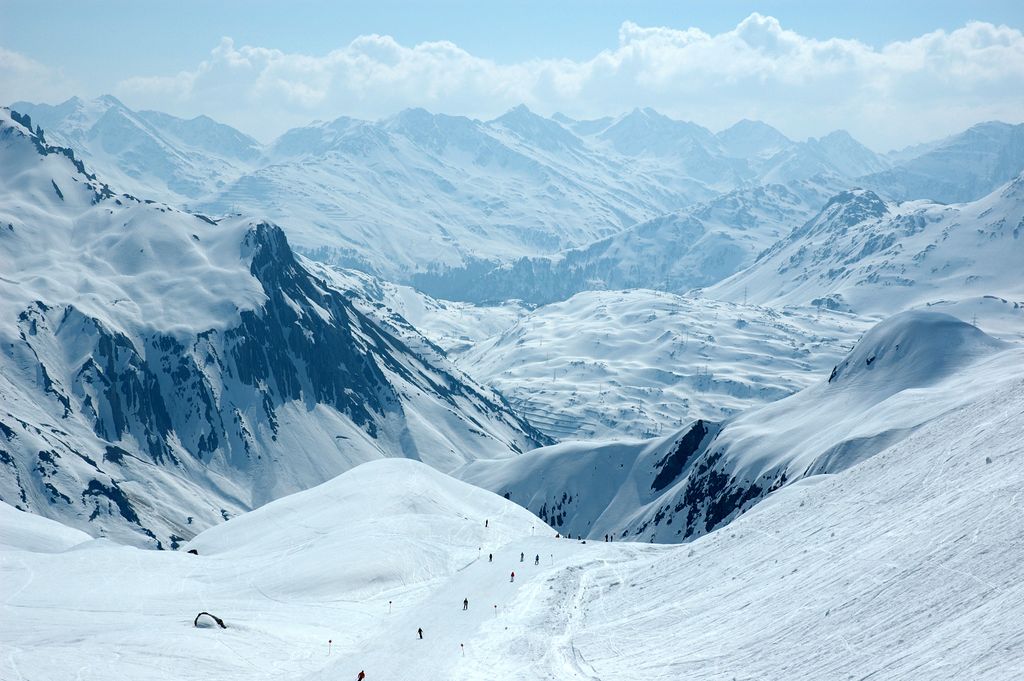
Ski Arlberg is in the Austrian states of Vorarlberg and Tyrol. Its many slopes are all part of the Lechtal Alps of the larger Tyrolean Alps.
Arlberg is accessed via several small alpine villages. The most significant are St. Anton, Lech, Zürs, and Warth. Though the ski area is contiguous, the nature of the terrain means that the towns are somewhat isolated from each other. For example, driving from Warth to St. Anton in winter takes about two hours, but a skier can traverse the distance in much less time.
The villages that support Arlberg form a rough L-shape. St. Anton sits at the bottom right, St. Christoph is directly to the left, Lech is about halfway up, and Warth and Schrӧcken are at the top.
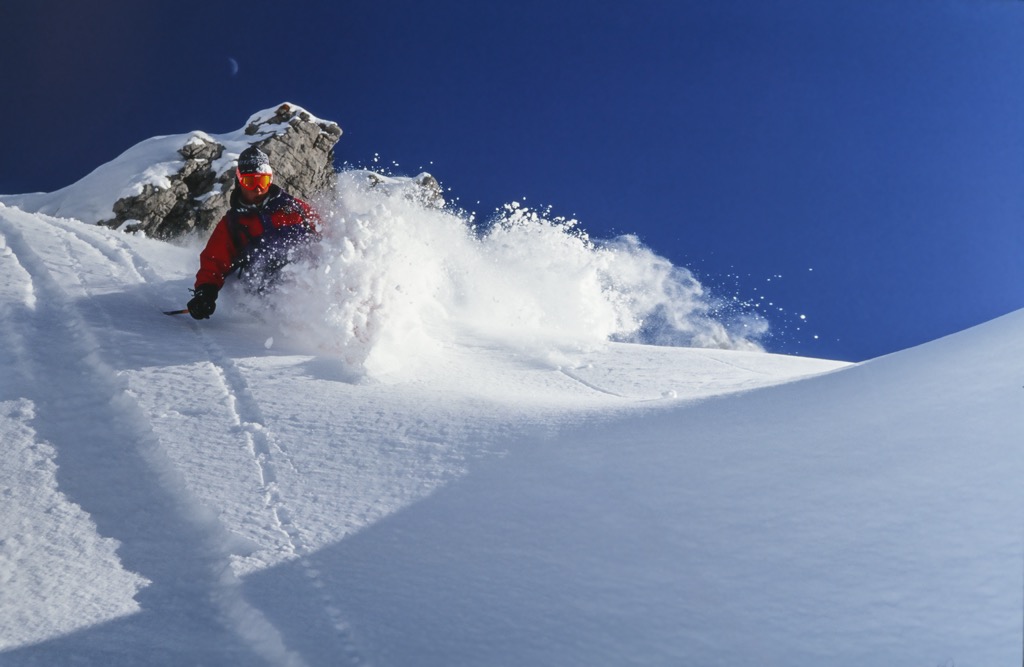
Though nestled within an expanse of near-impassable mountain peaks, Arlberg isn’t all that hard to get to. The first thing to consider is which part of Arlberg you want to visit. Though its many ski areas are connected via cable cars and slopes, the villages surrounding Ski Arblerg can be quite far away from each other. Winterlong pass closures mean that Warth and Schröcken are not directly connected by road to the other towns.
Just 100 km (62 mi) from St. Anton, the Innsbruck Airport is your best bet to fly to Arlberg. Other options are the Zürich Airport, about 200 km (124 mi) from St. Anton, and Munich, 250 km (155 mi) away.
St. Anton am Arlberg is relatively easy to reach by train. There are frequent trains between Innsbruck and St. Anton. The fastest line takes an hour and costs €50 during the ski season. The bus connections are equally convenient, taking about the same amount of time while costing less. If you’re flying to Munich, all train and bus routes to St. Anton will take you through Innsbruck.
The route from Zürich takes about 2.5 hours by train and generally costs over €100 even when booked far in advance.
Note that St. Anton is the only village in Arlberg with a train station. However, regular buses link it to the other villages.
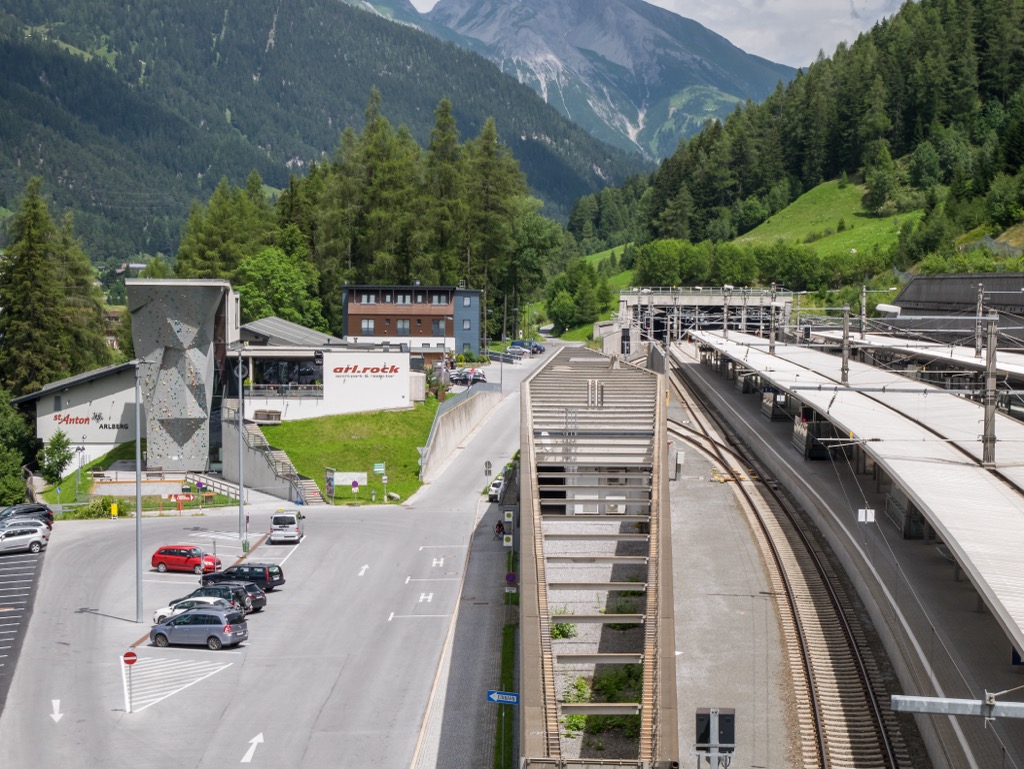
Though the train and bus links to Arlberg are robust, some skiers will prefer to drive. All drivers must purchase an Austrian Vignette to drive on Austrian highways legally. You can buy one online or at many petrol stations in Austria and near its borders. If your route takes you through Switzerland, you’ll also need a Swiss Vignette (€43).
Travel west on the A12 highway until it becomes the S16. If you’re staying in St. Anton, get off on Route 197. Skiers heading to St. Christoph must remain on the S16 a few kilometers longer. If you plan to access the ski area from Stuben, Lech, or any other Arlberg village, stay on S16 until Route 197 rejoins the expressway. Stuben is near the junction of 197 and 198, while Zürs and Lech lie to the north, accessible via 198. Note that the Flexen Pass between Lech and Warth is closed during the winter. It takes just over an hour to reach St. Anton from Innsbruck.
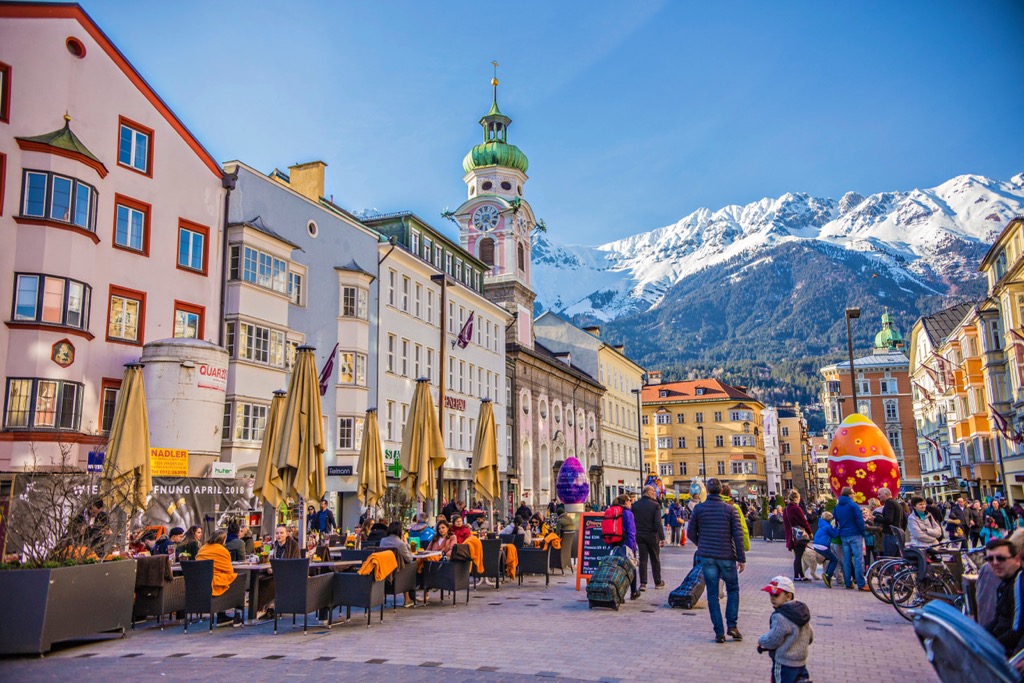
If you’re coming from Munich, drive south on A95 to the junction with B23 just north of the ski town of Garmisch. Proceed on B23 till it becomes Route 187 at the Austrian border. At the village of Lehrmoos, head south on Route 179. Drive over the Fernpass till you reach the A12. The trip should take about 3 hours, though winter conditions can cause delays.
Take the A1 towards St. Gallen and merge onto the A13. Cross the border at Hohenems and proceed south towards Feldkirch. Join the A14 highway and continue till it becomes the S16. In the best conditions, this route takes about 2.5 hours.
You’ll find free parking in Stuben, Zürs, Lech, Warth, and St. Christoph. St. Anton has multiple parking lots, all of which charge a daily rate of €7 per car and €20 for larger vehicles.
Two free bus lines connect St. Anton, St. Christoph, and Stuben. They are naturally geared toward skiers, providing ample space for people and gear. St. Anton and Lech also support free local bus services, providing an easy way to get from your accommodation to the lifts.
If you need to get from St. Anton/St. Christophe/Stuben to Lech/Zürs, you can take the 92 bus. This one isn’t free, however. There’s also a free bus that runs between Warth and Schrӧcken.
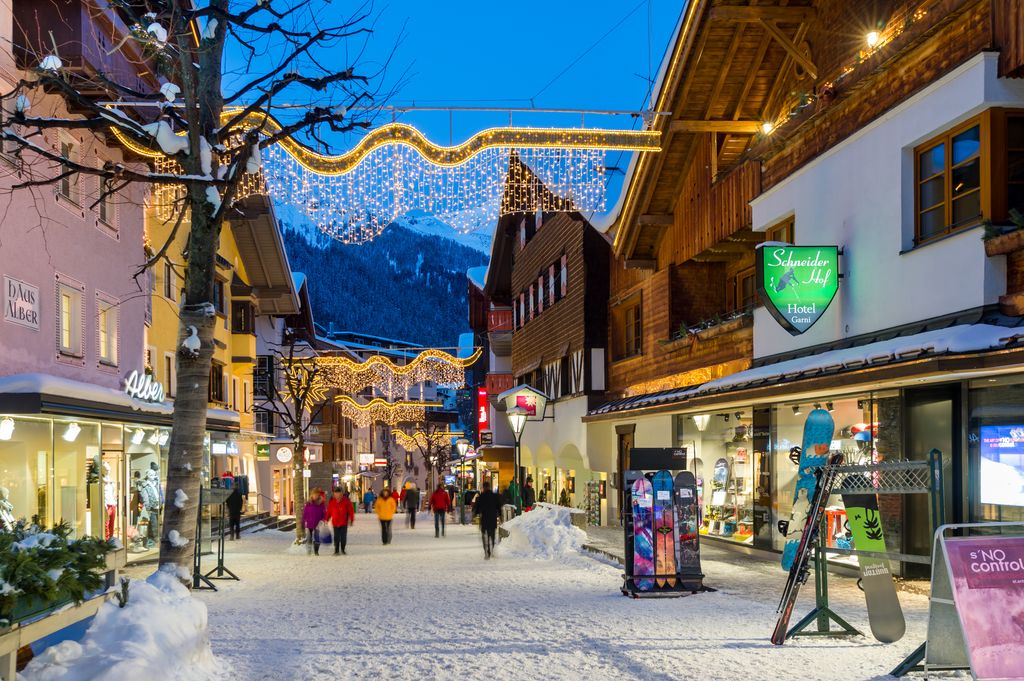
The mountains comprising Ski Arlberg start opening up in early December. The slopes officially close in late April, with the Warth-Schröcken areas opening later and closing earlier. The Arlberg website says their ‘main season’ runs from just before Christmas through the first of April.
The period around Christmas and New Year's sees the biggest crowds. After that, the crowds slowly disperse, with March less busy than February.
Arlberg gets plenty of snow — lack of coverage is never really a problem. With over 10 meters of snow per winter, Ski Arlberg is one of the snowiest resorts in the Alps.
The pace of snowfall usually creeps up throughout November and December, with February seeing the most frequent snowstorms. The snowfall tends to be consistent throughout the season, with an average of 3 snowy days per week from December through the start of April.
Being a high-altitude ski resort, Ski Arlberg experiences cold temperatures during winter. In the peak of winter, from December to February, temperatures often range from -10 °C to -5°C (14°F to 23°F) during the day. However, temperatures can drop significantly lower, especially at higher altitudes and during the night.
The spring season is generally considered to start in March. This period sees consistent daytime temperatures above the freezing point. On sunny days, especially in April, the temperature can exceed 10°C (50°F).
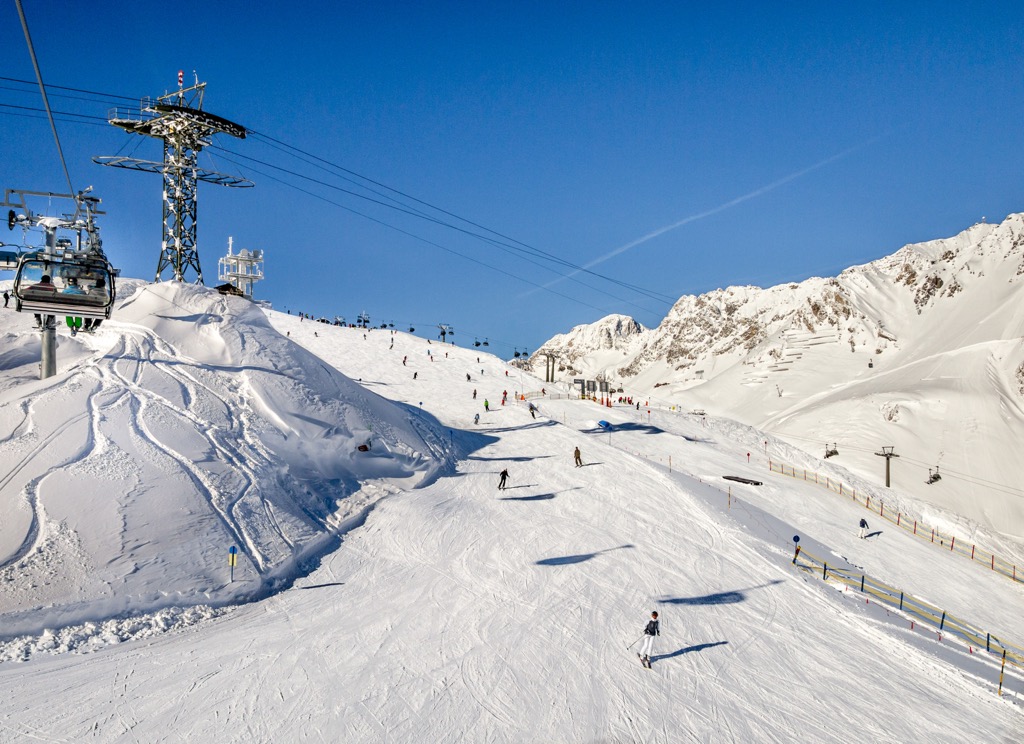
Ski Arlberg is so large that you might have a hard time believing it’s 100% contiguous. To help you get a handle on Ski Arlberg’s many mountains, we can divide the resort into three parts, each comprising at least two distinct areas.
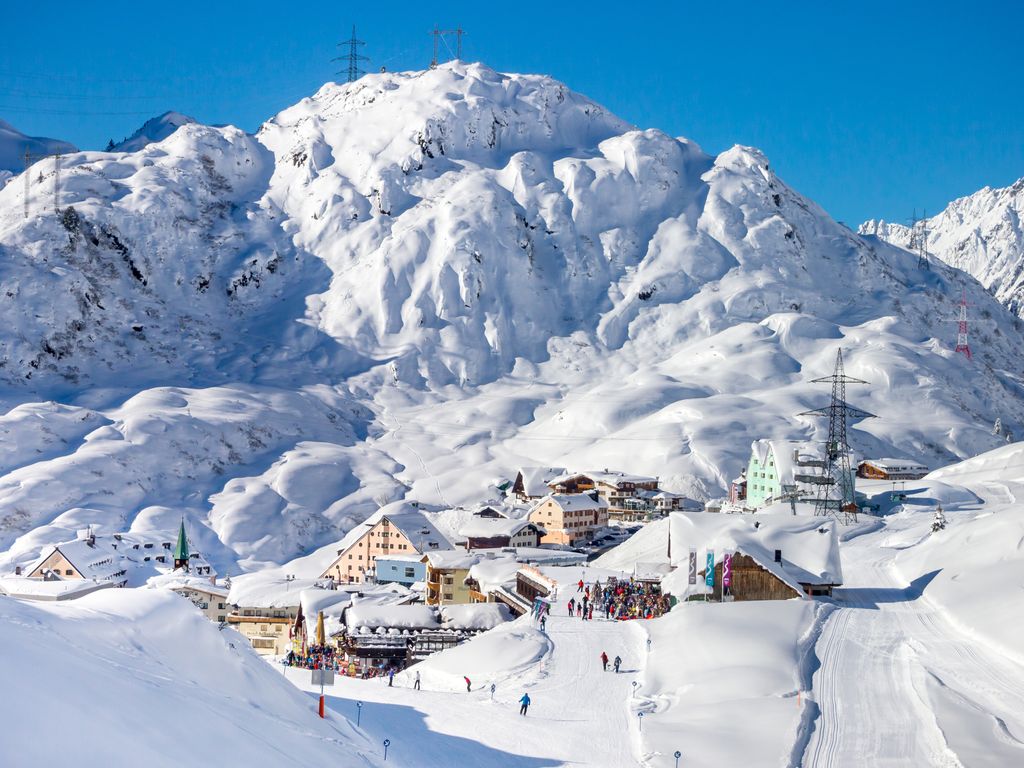
The highest bit of skiable terrain can be found at the top of Vallugabahn II (2,810 m / 9,219 ft). The maximum possible vertical drop is a massive 1,519 m (4,984 ft) — to experience this, you need to ski from the top of Vallugabahn II to the base of the Nassereinbahn (1,291 m / 4,236 ft). In addition, dozens of runs feature over 800 m (2,625 ft) of continuous vertical drop.
Generally speaking, you can find all types of terrain in each of Ski Arlberg’s three regions. Similarly, there are dining and après ski options in the main villages.
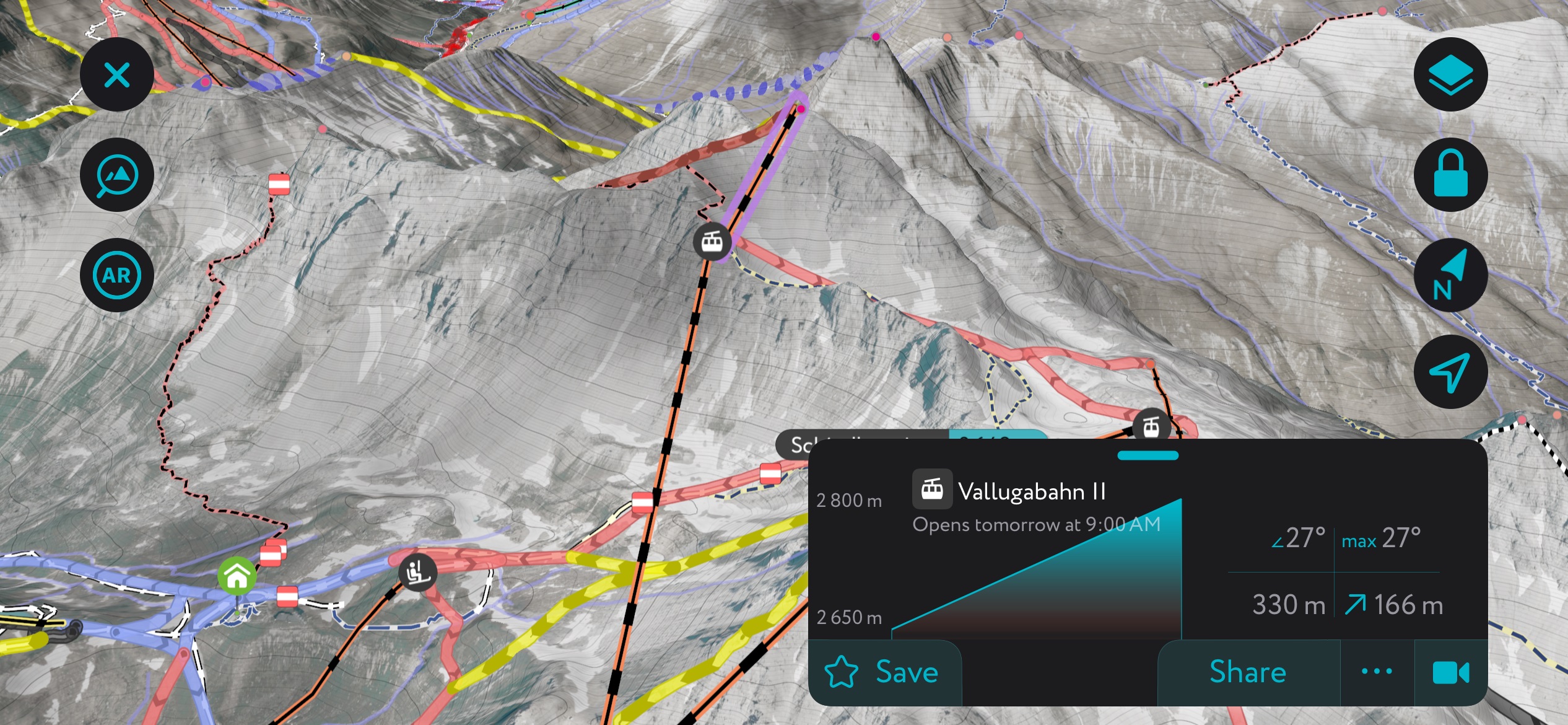
Given its size, it’s no surprise that Ski Arlberg has terrain for all kinds of skiers. From vertigo-inducing steep ski routes to pistes ideally suited for new skiers, there’s something for everyone.
Here’s the big picture:
There is a core distinction between pistes and off-piste ski routes. Pistes are controlled runs, which are groomed and maintained. This doesn’t mean all pistes are geared toward beginners; pistes are graded as either easy (🔵), moderate (🔴), or difficult (⚫).
Off-piste terrain is not maintained and can be rife with obstacles, including exposed rocks, cliffs, and snow furrows. Such dangers are rarely marked, and an avalanche kit is recommended. Off-piste skiing is known as ‘freeriding.’

Though all off-piste ski routes are considered experts-only terrain, they vary in difficulty. The easier routes are marked as red dashed lines on the map (– – –), while the more extreme routes are printed in black (– – –). Ski Arlberg has no shortage of epic ski routes to get your blood pumping.
Pistes and ski routes are given numbers rather than names on most maps. On-mountain trail signs will sometimes also provide names for specific runs, but this isn’t universally done as not all trails have names. In this guide, I will, for the most part, refer to specific runs by their given number.
People sometimes say St. Anton when referring to Ski Arlberg as a whole. St. Anton has some of Vorarlberg's best pistes, the most intense ski routes, the prettiest vistas, and the liveliest après scene. It’s also the region's largest village and ski area, so many guests choose to make St. Anton their home base while skiing Arlberg.
Arlberg East can be divided up into three sections. To the south of the village of St. Anton, you’ll find a beautiful swath of slopes at the foot of the staggering Rendlspitzen. This area is relatively small, consisting of only five main lifts, but it has the benefit of lighter crowds.
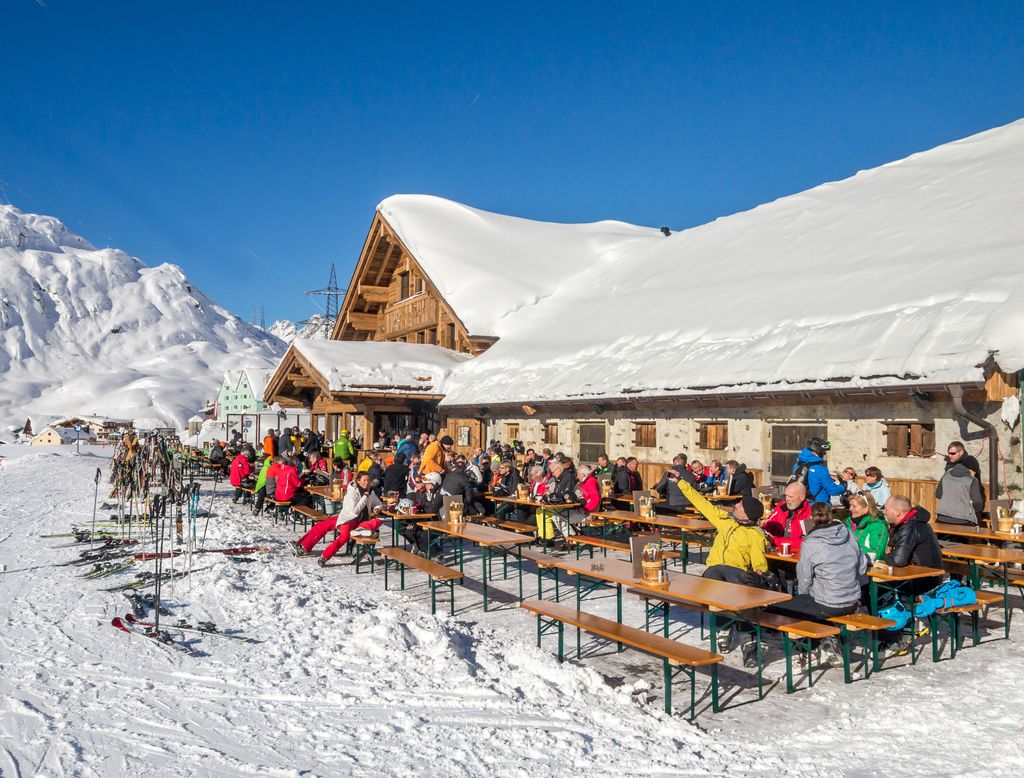
Across the road to the north lie the many south-facing slopes of St. Anton. This is the largest zone and home to many of Ski Arlberg’s most iconic peaks, including the Roggspitze and Valluga. Finally, there are the east- and west-facing runs between Stuben and St. Christoph. From here, skiers can transfer from the East to the West via the Flexenbahn.
The Rendlbahn services the southern part of St. Anton. A short walk from the Galzigbahn, this cable car will take you to some solid intermediate runs. From here, you can ski down to Riffelbahn I, a 2-person lift serving a high-altitude beginner area. The Salzboden T-bar provides access to the Stanton terrain park and Ski Route 10, one of the few options for advanced freeriders in Rendl. There’s also a public giant slalom course off of the Gampbergbahn.
The Rendl Restaurant and Beach Bar serves food, so there’s no need to return to town if you need a recharge. It has excellent views and a festive atmosphere.
On the subject of views, this whole area has stunning views of St. Anton across the valley. It’s worth a visit for this reason alone. The chairlifts here are indeed a bit old and slow (most are two-seaters), but it’s not without its charms. Rendl also tends to be much less busy than the rest of St. Anton, a massive advantage in my book.
When you finish exploring this southernmost part of Ski Arlberg, return to St. Anton proper via Piste 1. It’s a long and thrilling intermediate run with incredible views of the peaks across the valley.
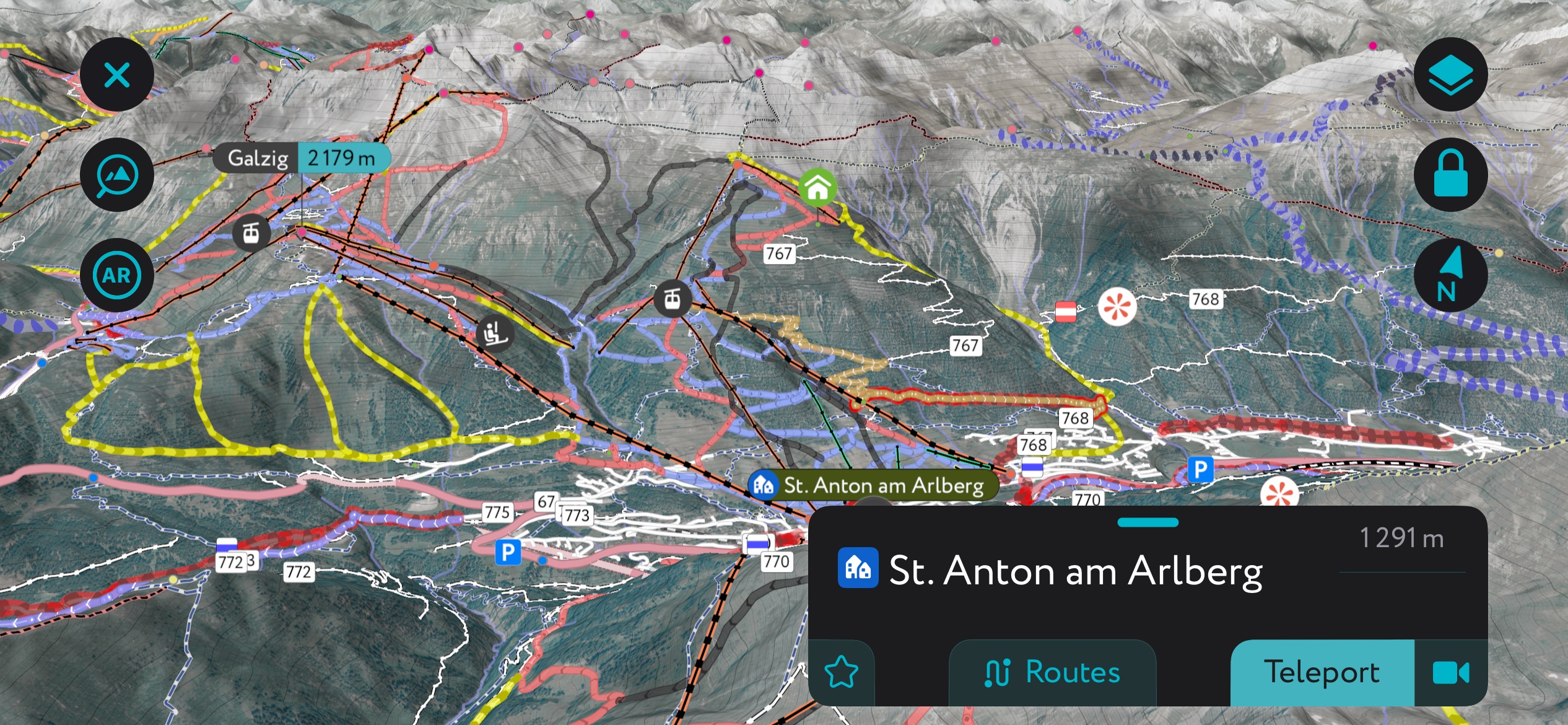
The ‘main’ part of the St. Anton ski area covers a vast area north of the village, up to the peaks towering over the valley. It can be divided between upper and lower, with the lower elevations hosting more beginner terrain. Vast yet accessible, the south-facing slopes of St. Anton are home to much-loved pistes and several on-mountain dining options.
Five beginner lifts and T-bars extend from Nasserein at Ski Arlberg’s easternmost point to the Galzigbahn in the west. The Nasserein gondola and Gampen lift provide access to the lower elevation areas above St. Anton, offering beginner and intermediate skiers variety. The Gampenbar is at the top of these two lifts. It’s a good spot for lunch or drinks if you don’t want to eat at the base.
Perilous-looking pinnacles, including Valluga, the highest peak in Arlberg, dominate the slopes above Gampen. From here, the Kapall lift will take you to higher-elevation terrain. A handful of runs range the difficulty spectrum, including two experts-only off-piste runs (ski routes 40 and 41). It’s a great spot to be if you want longer runs. There are beginner, intermediate, and advanced runs all the way down, representing a vertical drop of over 1,000 m (3,281 ft). You’ll need to take two lifts to run loops, but this still makes for very efficient skiing.
West of the main village lies another face with mid-altitude terrain, which you can reach from the base via the Galzigbahn or the Zammermoos lift. You’ll mostly find beginner terrain here, but the difficulty is a step up from what you find at the base of St. Anton.
Under the Galzigbahn and above the main village, you’ll find some of the rowdiest après scenes imaginable. There’s Mooserwirt, which calls itself “probably the worst ski hut in Arlberg,” the Krazy Kanguruh, and others. Both are emblematic of St. Anton’s famously exuberant drinking culture.
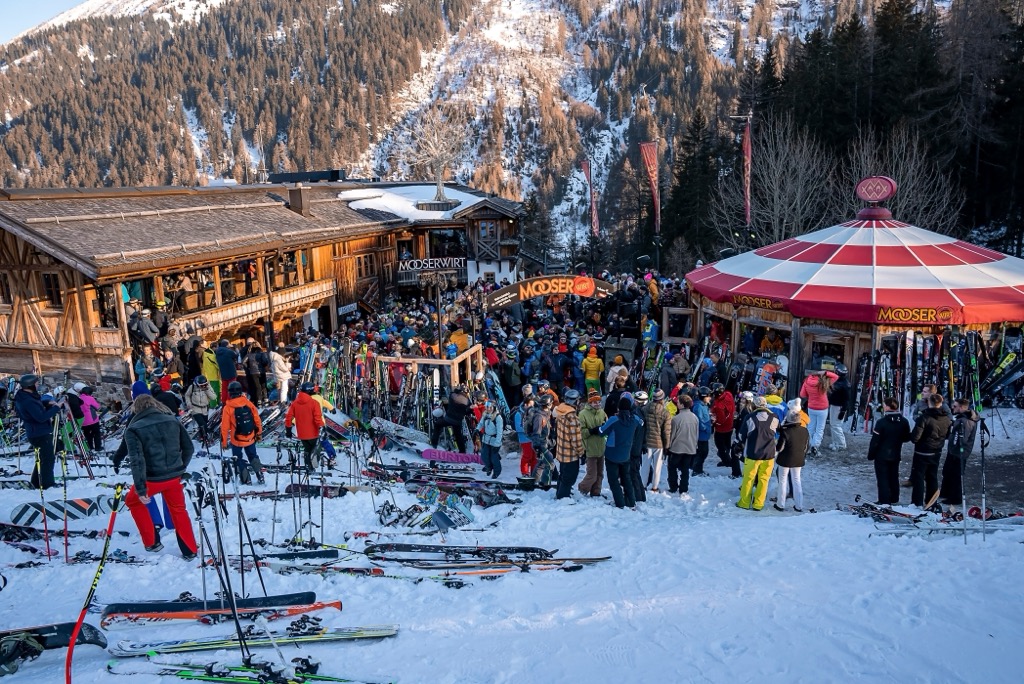
It isn’t all newbie runs, however. Ski Route 51 is a good entry point for aspiring off-piste skiers and freeriders. Furthermore, there are some great runs down to St. Christoph. You can reach it from the top of the Galzigbahn, but for the best runs down to St. Christoph (including some exciting ski routes), you’ll need to take the Osthang, Zammermoos, or Tanzböden lifts.
Finally, there’s Valluga, the monstrous peak overlooking St. Anton. It offers incredible views and equally unforgettable ski routes. To get to Ski Arlberg’s highest point, take the Galzigbahn to Vallugabahn I. If you want to reach the summit, take a brief ride on Vallugabahn II (feel free to grab a beer or Schnitzel at the Valluga Restaurant before reaching the top). Some freeriders trace their own routes from this point (some skiing all the way down to Zürs). If you’re new to the area and unfamiliar with off-piste skiing, the routes from Vallugabahn II shouldn’t be attempted without a guide.
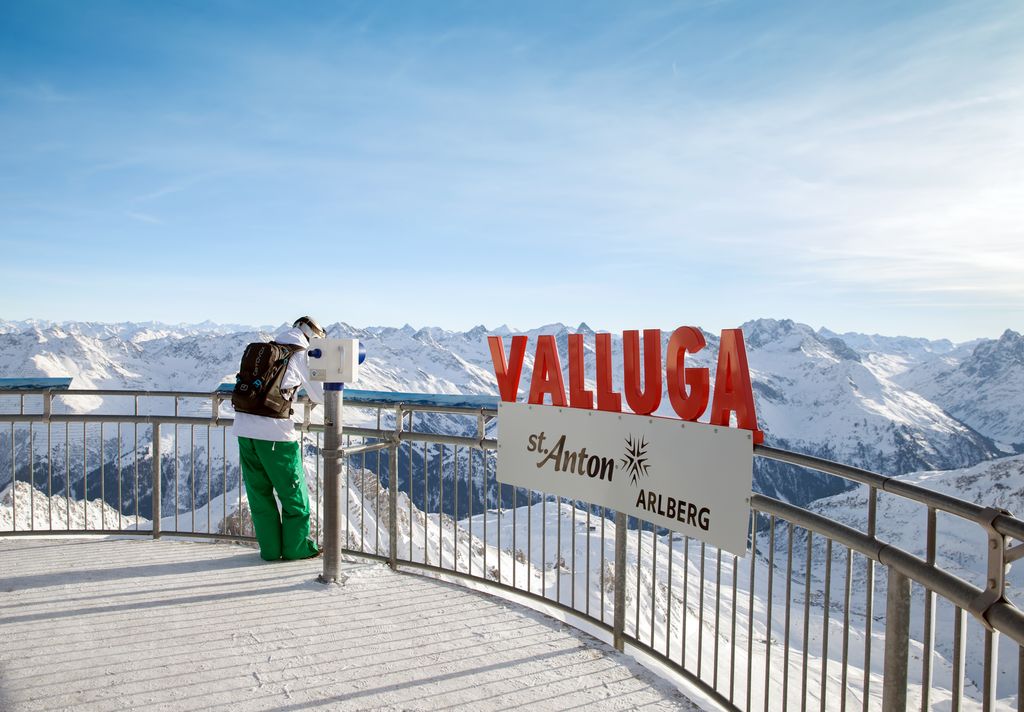
Though slightly lower, there are incredible runs from the top of Vallugabahn I. Simply ski down to the Valluga T-Bar, and you’ll have good options. If you want to stay on the piste, Valfagehrjoch (Run 85) is a moderate trail down to the top of the Arlenmӓhder lift. For maximum vertical drop, you can ski to the base of St. Anton (via Runs 76, 56, 55, and 50), or down toward St. Christoph (via Run 77), or even Stuben (via Run 100).
Those are all great runs, but Valluga’s ski routes make this a next-level lift. Route 90 is one of my all-time favorites, as it is a powder goldmine. Route 87 is similarly epic (though a little shorter), while 86 and 88 are easier. Even on the less intense routes, backcountry precautions are mandatory. This area has plenty of hazards, so it’s crucial to follow route markers and come with avalanche gear.
You can also get to the Valluga backcountry via the new Schindlergratbahn. Getting off at the second stop lands you in the same place as the Valluga T-bar. Depending on which routes you’re running, you can do laps in this area by taking the Zammermoosbahn to Vallugabahn I or the Schindlergratbahn.
Finally, there’s the area between St. Stuben and St. Christoph. I’ve already discussed some of the runs from Galzig to St. Christoph, so there isn’t too much to address here. You can get to St. Christoph directly from the Galzig area (the ridge that hosts the top of the Galzigbahn, Osthangbahn, Zammermoosbahn, and Tanzbödenbahn) by several on-piste runs and ski routes.
St. Christoph itself has three beginner T-bars and a cross-country area. There’s also the Arlenmähderbahn, a lift that takes you directly to the Ulmer Hütte. This on-mountain dining establishment earns a mention for its cozy atmosphere. It’s small and tends to get crowded, but the atmosphere makes up for the lack of space.
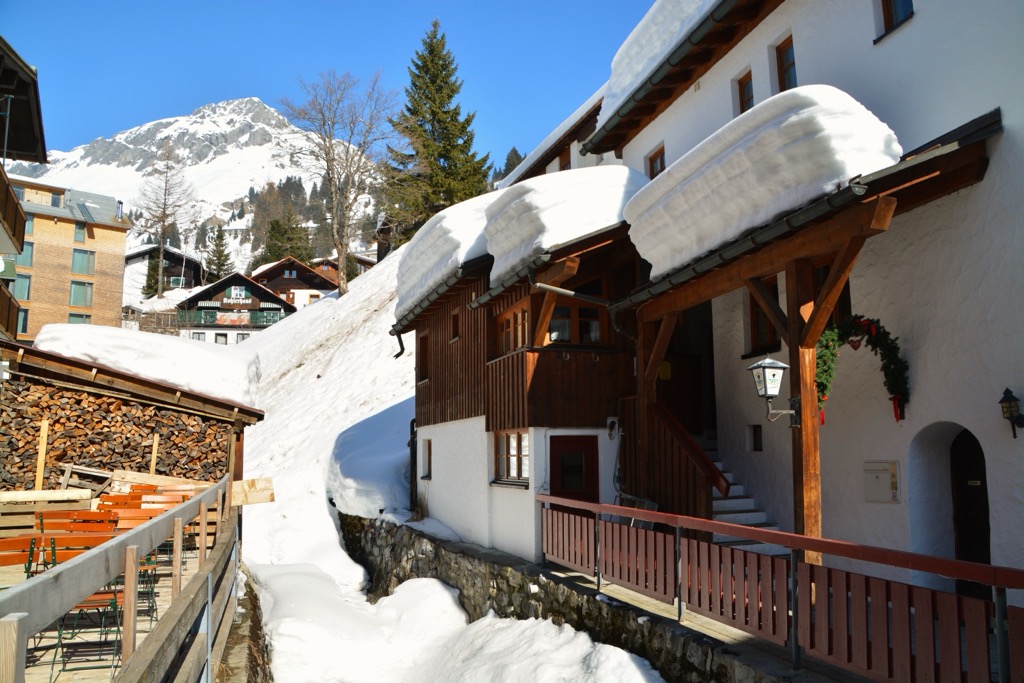
From the Ulmer Hütte, you can ski down to Rauz, a small settlement outside Stuben. Rauz is home to a beginner lift, the Flexenbahn cable car (which grants access to the western and northern parts of Ski Arlberg via Zürs), the Valfagehrbahn, and the Albona II gondola.
The Valfagehrbahn doesn’t give access to much terrain, but you’ll need to take it if you’re returning to St. Anton. It also serves Route 101, an off-piste run requiring a bit of hiking (usually worth it). You can also ski directly to Stuben via Run 102.
The Albonabahn is a cable car with a vertical rise of 680 m (2,231 ft), providing access to solid intermediate pistes that usually don’t see large crowds. The Albonagrat (a two-person chair) also serves the area and has a full-service restaurant. From this mountaintop perch, there are multiple routes down to Stuben, some easy, some intermediate. Stuben proper also has two T-bars servicing a small beginner area.
This one is a bit of an ‘honorable mention’ as it isn’t directly connected to the rest of Ski Arlberg, but given that the Sonnenkopf resort is included with the Arlberg pass, it’s worth a shout. Sonnenkopf is just outside of Klӧsterle, a short bus ride from Stuben. Billed as a family ski area, Sonnenkopf is generally far less crowded than most other parts of Ski Arlberg. The biggest downside is an almost complete lack of the type of terrain that expert skiers crave.
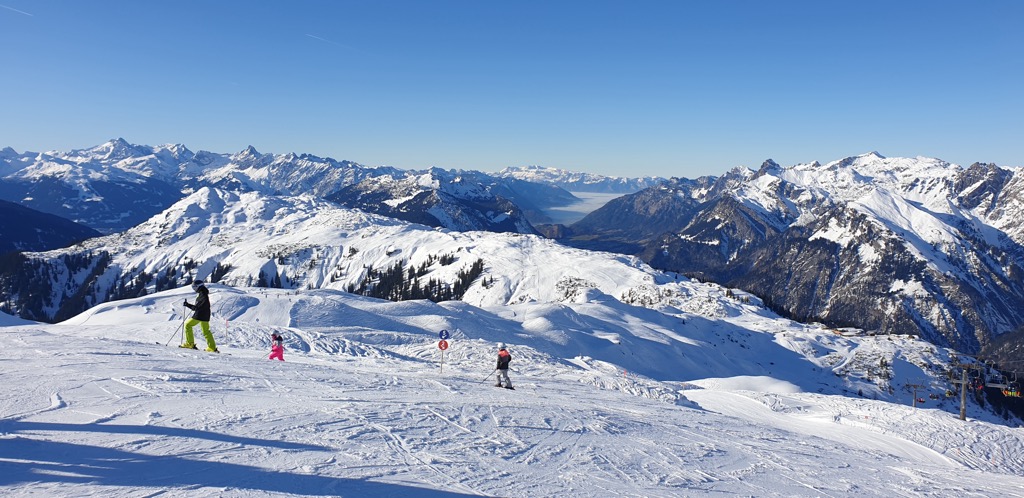
The vast middle portion of Ski Arlberg covers a huge area, from Zug in the west to Stubenbach in the east. This region centers around Lech, a village smaller and less lively than St. Anton but a tremendous base nonetheless. Sometimes simply called Lech-Zürs, this region includes those towns as well as the Zug, Oberlech, and the Rüfikopf ski area.
We can divide the West into two subsections to help you get a handle on this massive ski area. The first is the southern region, directly north of Stuben. It stretches from the Madlochbahn in the west to the Hexenboden peak in the east, with the town of Lech as the northern boundary.
The northern part comprises the Oberlech area, the Zug peaks, and Rüfikopf (the peak overlooking Stubenbach).
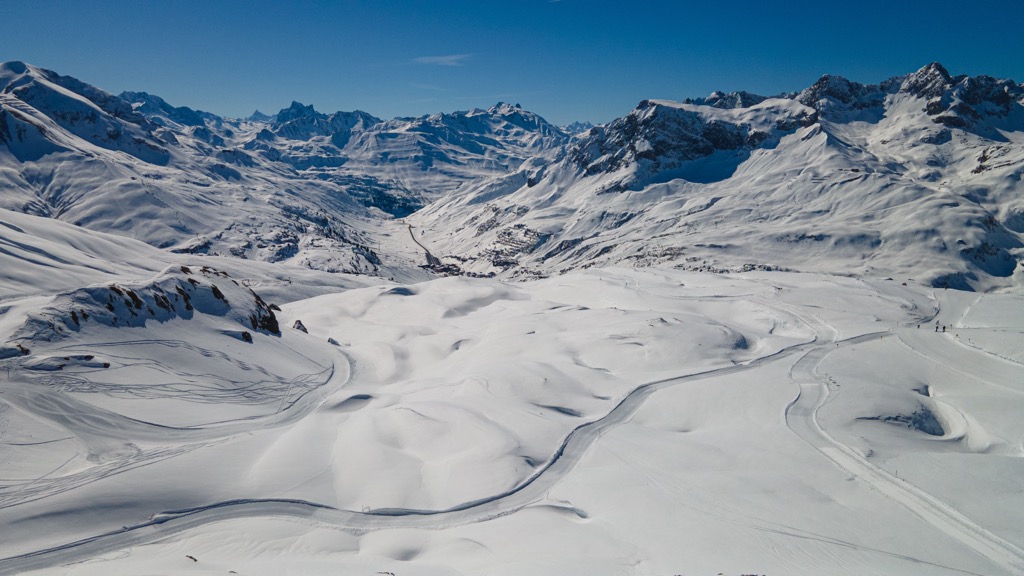
The Flexenbahn cable car connects the Lech-Zürs to St. Anton. You have two options when you step out of the car and into your skis. You can ski down to the town of Zürs by way of a difficult off-piste route or a moderately difficult piste.
You can ride up the Trittkopf II lift to Run 134 if you're seeking a longer run. Nicknamed ‘Balmen’ by those in the know, 134 is an excellent intermediate run with a vertical drop of almost 700 m (2,297 ft) down to Trittkopfbahn I. Alternatively, Trittkopf II serves as the entry point for some solid, moderately difficult off-piste runs.
Though smaller than Lech or St. Anton, the village of Zürs has a few hotels, restaurants, a cross-country track, and several chairlifts. In addition to hosting the base station for Trittkopfbahn I, there’s a relatively large beginner area with aptly named lifts: two ‘Babybahn’ T-bars and the Übungshangbahn (German for practice run lift).
The Hexenbodenbahn offers intermediate and beginner pistes, with a few more accessible via the Trittalpbahn (where there’s also a restaurant).
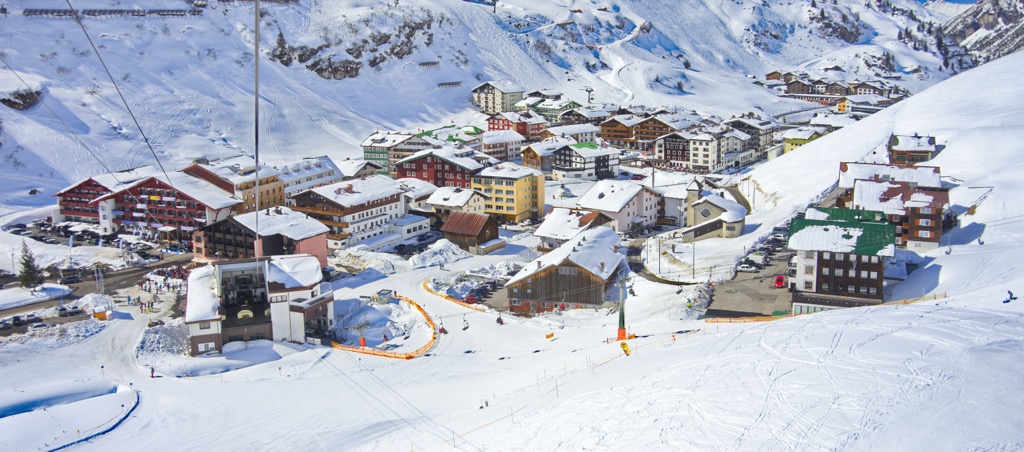
On the opposite side of Zürs, the Seekopfbahn and Zürserseebahn ascend the slopes west of the village. They start in different areas but serve the same terrain. It’s a nice little area, with pistes for skiers of every experience level (save for first-timers) and even a pair of challenging off-piste routes. Each lift rises about 500 m (1,640 ft), making this area one of the best places to do laps on a variety of terrain — at least when the crowds are away.
It is possible to ski from Zürs to Lech from the top of the Zürserseebahn and Seekopfbahn. A relatively easy off-piste run (Route 160) takes you to the southern side of Lech (and a much longer route via Zug), but the fastest way for most skiers is via the free bus.
The Madlochbahn and Muggenratbahn have their base stations near the tops of the Seekopfbahn and Zürserseebahn. The Muggenratbahn is basically a single-purpose lift, the purpose being access to Muggengrat Täli (Run 144), a great intermediate piste through a steep valley. Over 4 km (2.5 mi) long and descending 720 m (2,362 ft) to the base of the Zürserseebahn, this scenic piste is one of Ski Arlberg’s most famous.
If you’re ready to leave the Zürs area, take the Madlochbahn. The lift also serves a single intermediate piste, but its real purpose is to link the southern part of Lech-Zürs to the north. To make this traverse, you must ski off-piste, so beginners beware. As far as ski routes go, the runs going from the top of the Madlochbahn to Zug are relatively straightforward. Still, avalanche precautions are nonetheless required. A third path (Route 173) will take you to Lech. It's one of Ski Arlberg's most vertiginous runs, with a drop of almost 1,000 m (3,281 ft).
Whether you reach the northern part of Lech-Zürs via bus, ski route, or cross-country trek, you’re in for a treat. For the purposes of this guide, we’ll zoom back to the town of Lech before making our way to Zug and Lech’s other outlying areas.
As a town, Lech is smaller than St. Anton, but it still has everything you need. Overall, it feels fancier and has many more options for travelers with a high budget. The après scene is more low-key, but you’ll still find plenty of thirsty skiers at the end of the day. Lech has two T-bars serving beginner areas and even a dedicated sledding hill. However, Lech isn't the best if you’re a first-timer, as Zürs and St. Anton have larger beginner areas with better lift infrastructure.
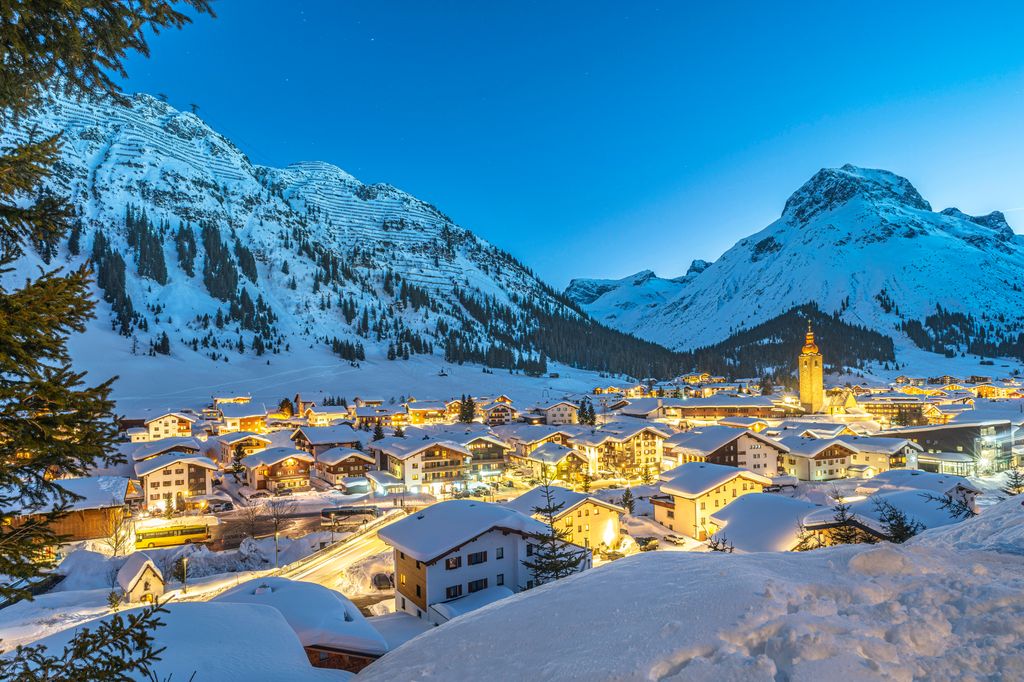
Rüfikopf, a majestic peak to the southeast of Lech, is accessed by the Rüfikopf gondolas. This pinnacle hosts stunning panoramas and a fine example of a traditional Austrian alpine restaurant.
The Rüfikopf peak is home to a handful of epic off-piste runs. Ski Routes 181 (named Steinmännle) and 182 (Rossgraben) are doable even for skiers without much backcountry experience. It also provides an easy way for skiers to transit from the northern part of Lech-Zürs to the south. From the top of the Rüfikopf, it’s possible to get all the way back to the Flexenbahn skiing easy runs. Just ride Trail 180 to the Schüttenbahn and then ski to the Trittkopfbahn I.
Experts looking for a long run with many challenges will be tempted by the long route to Oberlech. Simply ski down to the Schaffelplift T-bar and take Ski Route 215/217 (Langerzug/Tannegg) all the way to the Schlosskopfbahn. This is a trying but rewarding off-piste run with excellent views and a vertical drop of over 900 m (2,953 ft). Langerzug covers some of the steepest skiable terrain the Alps offer, so it is a must-ski run for experienced thrill chasers.
The Rüfikopf is isolated from the rest of Lech-Zürs because it isn’t feasible to run laps on it. Still, the terrain it serves is exceptional and well worth it for experts looking to ski off-piste. Even if that isn’t you, I recommend everyone try it, even if only at the end of the day as you look to return to St. Anton. This area is also notable for being the start of Der Weisse Ring (The White Ring), an iconic 22 km (14 mi) race circuit.
Zug is the westernmost part of Lech-Zürs and has great low-altitude off-piste routes and a higher area with a wealth of intermediate pistes. In case you’ve forgotten, Zug is connected to the southern part of Lech-Zürs by an off-piste run from the top of the Madlochbahn, a high-elevation area west of Zürs.
Though one of the smallest villages in Arlberg, Zug isn’t without amenities. It has a handful of hotels, guesthouses, and restaurants but no dedicated bars. If you’re interested in staying somewhere quieter and more out-of-the-way, Zug is worth considering. It’s also connected to Lech via a mostly flat 2.8 km (1.7 mi) cross-country route.
When it comes to downhill skiing from Zug, there’s only one option to go up: the Zugerberg gondola. This 10-seater rises over 600 m (1,969 ft) above the village and provides access to the rest of the Lech ski area and some excellent backcountry skiing.
Well-versed off-piste skiers will doubtless appreciate Zuppert (Ski Route 178) — it was undoubtedly one of the highlights of my last trip to Arlberg! If you follow the signs and snow coverage is good, the run doesn’t have many hazards. As the access is more complicated, it retains a lot of powder and is a great place to do laps when there’s fresh snow. With enough speed, the cross-country route to Lech is easily traversed from this vantage point. Your other option is to take Ski Routes 215 and 177 back to the Zugerbergbahn.
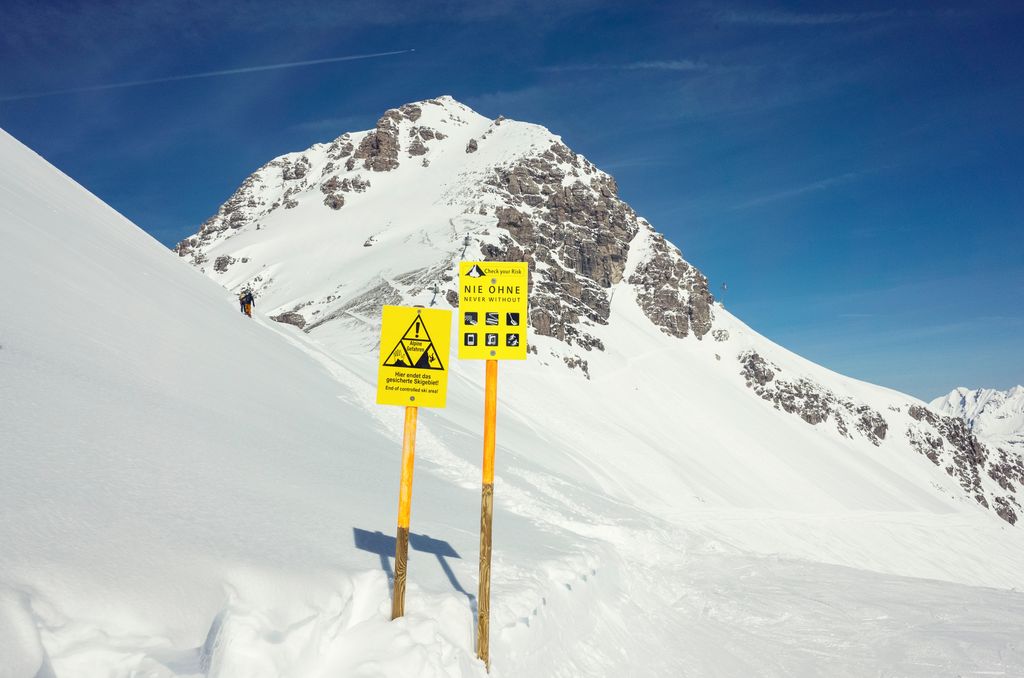
If you prefer on-piste skiing or are ready to try different terrain, take the Balmengrat T-bar as you exit the Zugerbergbahn. From here, you can take Kriegeralpe/Run 200 (the final run of the White Ring race course) down to Lech or explore the higher elevations of Zug by skiing down to the Steinmӓhderbahn.
Rising 487 m (1,598 ft), the Steinmӓhderbahn serves a decently sized area consisting primarily of intermediate terrain. There are a few short off-piste runs, but the trails leading down the Steinmӓhderbahn are generally well-suited to skiers looking to enjoy long, groomed descents.
From the top of the Steinmӓhderbahn, you can also head east toward the villages of Lech and Oberlech. The slope down to the base stations of the Rotschrofen, Hasensprung, and Kriegerhorn chairlifts is, like the opposite face leading to the Steinmӓhderbahn, a high-elevation area full of long pistes. The runs here, however, are more suited to beginner skiers.
The Rotschrofen and Hasensprung lifts serve similar terrain. The one notable exception is that the Rotschrofenbahn provides access to Bergeralpe (Ski Route 241), an off-piste area. Although relatively short in terms of vertical, it’s the run for experts looking to transit to Warth-Schröcken. Alternatively, take the intermediate 240 piste to the much easier 242 off-piste run. The Rotschrofenbahn is significantly slower than the Hasensprungbahn, so if you aren’t headed off-piste, the Rotschrofenbahn is the better lift to take in most cases.
Similarly, the Kriegerhorn chairlift provides access to the full 4.2 km (2.6 mi) length of the Kriegeralpe (Run 200). You can, however, access the majority of said run from the Hasensprung lift, so arguably, the primary purpose of this lift is to provide access to a pair of quite difficult off-piste runs: Südhang (Ski Route 202) and Osthang (Ski Route 203). Both are quite treacherous, with avalanche gear and knowledge of the area a must for anyone attempting them.
The Kriegeralpe Restaurant is accessible from the Kriegerhorn and Hasensprung lifts. It has excellent views, good food, and the cozy, festive atmosphere that makes Alpine chalets so appealing.

Below the base stations of the Kriegerhorn, Hasensprung, and Rotschrofen chairs, you’ll find a long swathe of beginner terrain leading down to Lech. This area stretches from the Hinterwies racecourse in the west to the Schlossköpfe ridge in the east.
First, it’s worth mentioning that there are many dining options in this area. There’s the Restaurant Shlegelkopf at the base of the Kriegerhorn lift and Der Wolf, located between the Petersboden and Weibermahd lifts. Both are modern in terms of design and cuisine. The village of Oberlech (which, as the name suggests, is just above Lech proper) also has a few restaurants.
Aside from the base lifts (I’ll get to those in a bit), the two chairs serving this area are the aforementioned Petersbodenbahn and Weibermahdbahn. The Weibermahd chondola (it runs both 8-seater chairs and 10-person gondolas) is pretty simple. If you’re coming from Lech to Warth-Schröcken via the Auenfeldjet, you must take it to the rest of the Lech-Zürs ski area. The Petersboden is likewise the lift you’ll need to take if you’re bound for higher altitude areas and begin by taking the Bergbahn aerial tramway.
Working from west to east, we’ll begin with the Hinterwies T-bar. Found at the western end of the village, it serves a short but well-maintained race course. You can scan your pass to have your overall time and top speed recorded. There’s even a photo-op at the end!
Next are the Schlegelkopf chairs, which start at roughly the same place and end at Restaurant Schlegelkopf. They begin in the center of Lech and rise about 367 m or 1,204 ft (the vertical rise for each lift is slightly different), accessing higher altitude lifts and beginner pistes.
You'll find the Rud-Alpe bar and restaurant between the Schlegelkopf lifts and the Hinterwies race course about halfway up the hill. Like Mooserwirt in St. Anton, it is a hugely popular après ski spot for those who can’t wait to get down the mountain before they start drinking. It doesn’t tend to get as rowdy, but you should still ensure you have the wherewithal to ski the rest of the way down before the sun goes down.
Just east of Lech’s center, an aerial tram leads directly to the village of Oberlech. On the south side of town, you’ll find a beginner area with a trio of T-bars and the base station for the Rüfikopf gondolas. It’s a fine place for first-timers, but there isn’t much else to say about this area.
Oberlech is small, about the same size as Zug, though far less isolated. It has a few restaurants, hotels, and guesthouses. The beds are more expensive than Lech proper, but every accommodation is a ski-in/ski-out. There’s also yet another beginner area served by a T-bar.
Just past the eastern end of the village of Lech lies the base station for the Schlosskopfbahn. It’s old and slow, but the newbie terrain it serves tends to be much less crowded than most other beginner base areas at Ski Arlberg.
The main notable sight in this area is Skyspace Lech, a permanent art installation by globally renowned artist James Turrell. If you’ve never seen a James Turrell piece, they tend to pop up in exciting locations across the planet. Like most of the artist’s works, Lech’s piece is a conduit for nature's beauty. It is intended to be visited only at sunrise and sunset. The installation requires good weather and advanced booking.
Though it’s often lumped in with Lech-Zürs, the Warth-Schröcken ski area is a mountain unto itself. The peak is named Tannberg and is connected to the rest of Arlberg via the Auenfeldjet, a monster of a cable car that flies over 2 km (1.2 mi) of treacherous terrain. Since 2013, it has linked the Warth-Schröcken and Lech-Zürs ski areas.
First, we must clarify that, as of 2023, the Warth does the heavy lifting of the Warth-Schröcken duo. There are ways to ski down to Schröcken, but there is no way back up aside from taking the free bus back to Warth. The ride only takes about 15 minutes, but it’s less than ideal. There are plans to construct a gondola from Schröcken to the ski area, but I couldn’t find concrete dates for when this might be complete.
Both villages are small and more comparable to Zug than Lech or St. Anton. They have lots in the way of accommodation, and several places to go for some après drinks, but the drinking and dining establishments are much more spread out than what you see in St. Anton, Lech, and even Zürs.
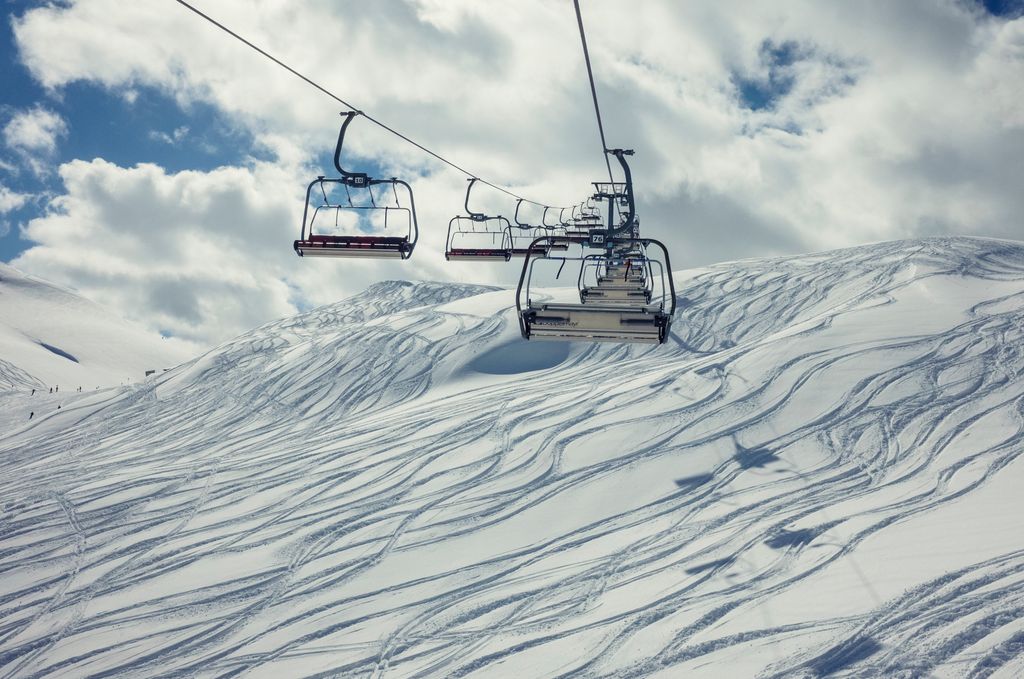
As for the ski area, Warth-Schröcken is the smallest of Ski Arlberg’s regions. The maximum vertical differential is only slightly over 500 m (1,640 ft), about a third of what is possible in St. Anton.
Despite its lower elevation, Warth-Schröcken gets more snow than other parts of Arlberg. Though smaller, it still has excellent terrain for skiers of all ability levels. It has multiple lifts serving pistes of every difficulty rating. There is a distinct lack of off-piste possibilities, but this will only upset a relatively small subset of alpine skiers.
Dividing up the ski area is pretty simple: the southwest-facing face above Schröcken and the north-facing area over Warth. The two parts are divided by a long ridge formed by the Saloberkopf incline.
Coming off the Auenfeldjet, skiers arrive in Warth-Schröcken just above the base of the Sonnen-Jet chairlift. It rises 390 m (1,280 ft) to the top of the Saloberkopf and covers a handful of pistes. Two are rated for beginners, and there is one each for intermediate and advanced skiers. The beginner pistes (259 and 254) wind down to the Sonnencruiser chairlift while the rest lead back down to the base station. The Sonnencruiser chair doesn’t go as high, but it's a great option for easier runs.
From the top, you can ski down to the base station, the Sonnencruiser, the Spielboden side of the Ski-Schaukel Falken lift, or all the way to the Warth side via Schöniplätz (Run 254), a long and pleasant beginner piste.
The Ski-Schaukel Falken lift has two base stations located in different valleys. These both lead to the top station, where all passengers must disembark. The Spielboden side (the one on the right if you’re looking at a trail map) hosts two runs, both of which are quite short. There’s a beginner piste and a ski-route. As far as off-piste skiing goes, it isn’t super challenging or dangerous, making it an ideal place for aspiring freeriders to get their feet wet. The Körbersee side serves a single blue-rated piste.
This lift is also the best entry point to take one of the off-piste routes down to Schröcken. As I mentioned, this is a tricky proposition as, unless you’re staying in Schröcken, you’ll need to take a bus to get back on the mountain. Nevertheless, it can be well worth the trip as Nesslegg Schröcken (Ski Route 310) is seldom skied, so there's usually plenty of powder.
The area has two on-mountain dining options: the Berggasthof Körbersee and the Auenfelder Hütte. The former is also a hotel and serves traditional food, while the latter is smaller and suitable for snacks and more basic meals. You’ll find the Berggasthof on the Körbersee side of the Ski-Schaukel Falken, while the Auenfelder Hütte is between the Sonnen-Jet and Sonnencruiser lifts.
Like the Sonnen-Jet, the Salober-Jet and Hochalpbahn drop skiers off at the top of the Saloberkopf. The Salober-Jet services three criss-crossing pistes with a difficult rating. They’re decently long and present a challenge even for skilled skiers. Naturally, skiing down to Warth is also possible. You’ll find two dining options at the base station: the S1 Lounge and, if you’re looking for something more casual, the SB Restaurant.
The Kuchlbahn starts just below the Salober-Jet’s base station and goes to that lift’s halfway point. It’s an old 2-seater with one beginner and one intermediate piste. You can take the easy slope down to the lodge at the base of the Salober-Jet. A T-bar at the base of Kuchlbahn also leads to the restaurants.
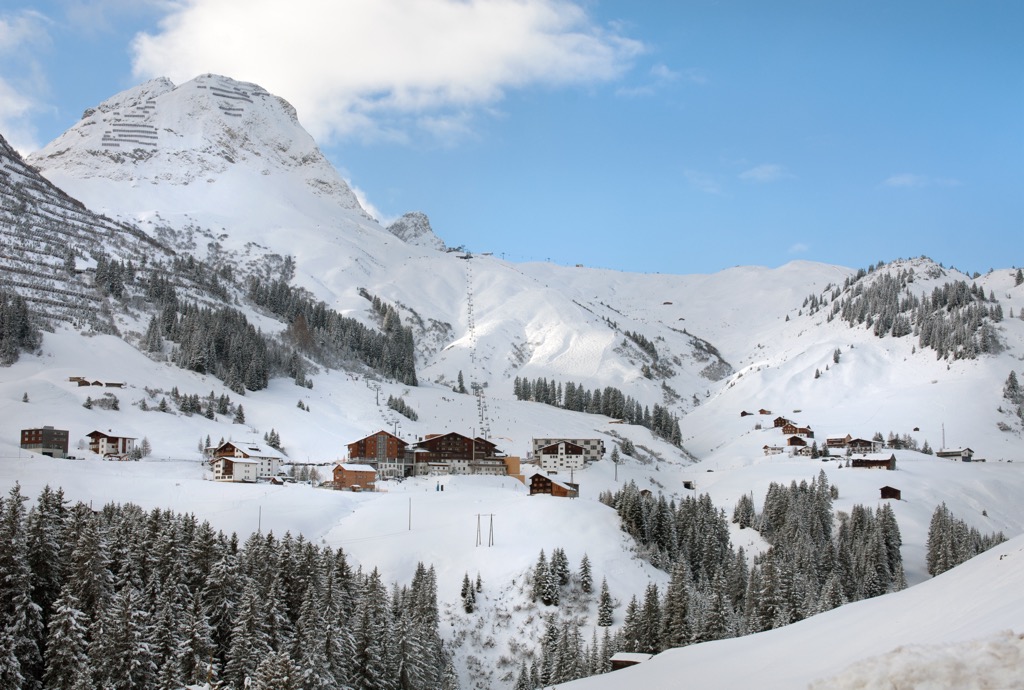
The Hochalpbahn ends near the top of the Salober-Jet and mainly serves beginner-graded pistes. A traditional alpine hut also serves food and food and drinks in the middle of the run. Looking at a map, you’ll see that the Karhorn lift is near the Hochalp’s base station, but you can’t ski to it unless you’re prepared to hike (more on that lift in just a moment).
The Jägeralp-Express is a base lift that begins to the west of Warth. From the top, you have easy, moderate, and difficult pistes to choose from. Walserschuss (Run 283) deserves a mention as a long, black-rated piste back down to the base. There’s also an off-piste option (Ski Route 301) if you want more of a challenge.
Dropping skiers off in roughly the same place, the Wartherhorn-Express is the lift to take if you don’t want to ski down to the base. You’ll find another hut at the bottom of the lift where you can get drinks, warm up, and enjoy a simple meal.
These two lifts also provide access to the aforementioned Karhornbahn. Simply take the easy Bremstel slope (Run 291) and find its base station. The Karhorn chair takes you to the highest point in Warth-Schröcken. The beginner and intermediate pistes it serves tend to be less crowded than others in Warth, so it’s sometimes a good place to do laps.
The village of Warth has a gondola and chairlift serving a beginner's area, as well as a T-bar (found on the north side of the road). The only way to get to the rest of the mountain is via the Steffisalp-Express. From the top, you can take an easy piste (Run 272) to the Wartherhorn-Express or ski all the way down on either red- or black-rated pistes. Ultimately, I would say the Jägeralp lift is the better way to start your day when it comes to accessing Warth’s terrain, but the fact that it begins outside of Warth itself means it might not be easy to get to, depending on where you’re staying.
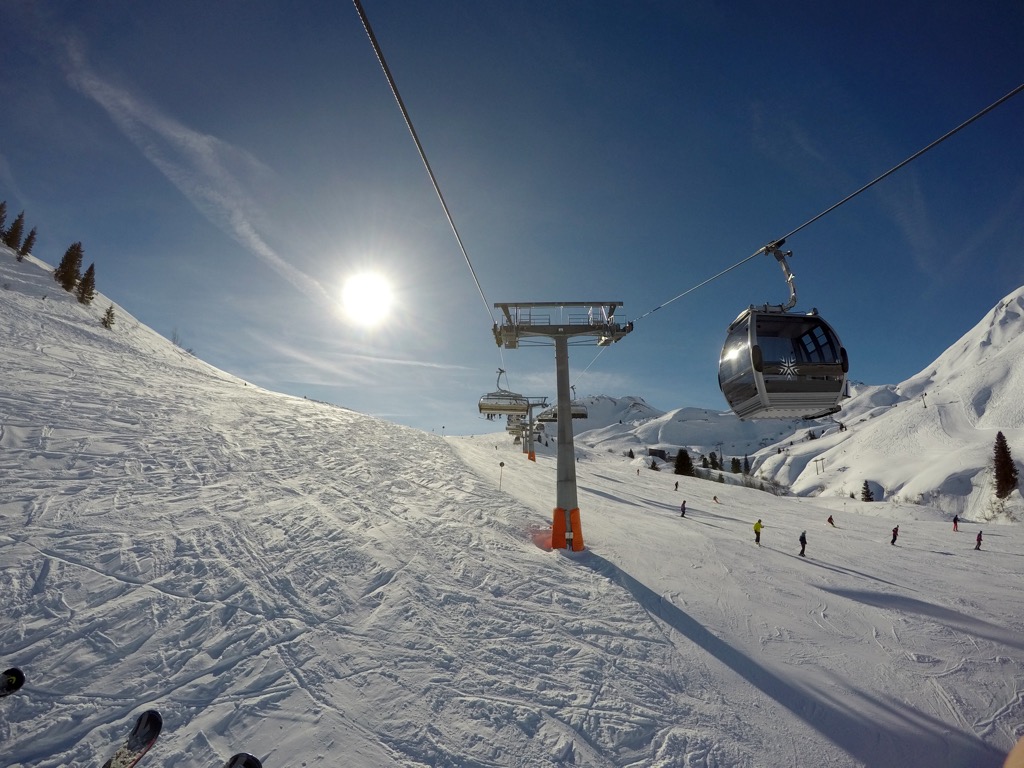
Arlberg is a vast ski area. Here are some numbers to put all this into perspective:
Slopes
Ski lifts
Other features and services
There are many cross-country trails around Arlberg, with St. Anton having the greatest length of track. A trail runs across the entirety of town south of the road. There’s also a circular track outside Zürs, several trails around Warth, and a well-trafficked route between Zug and Lech.
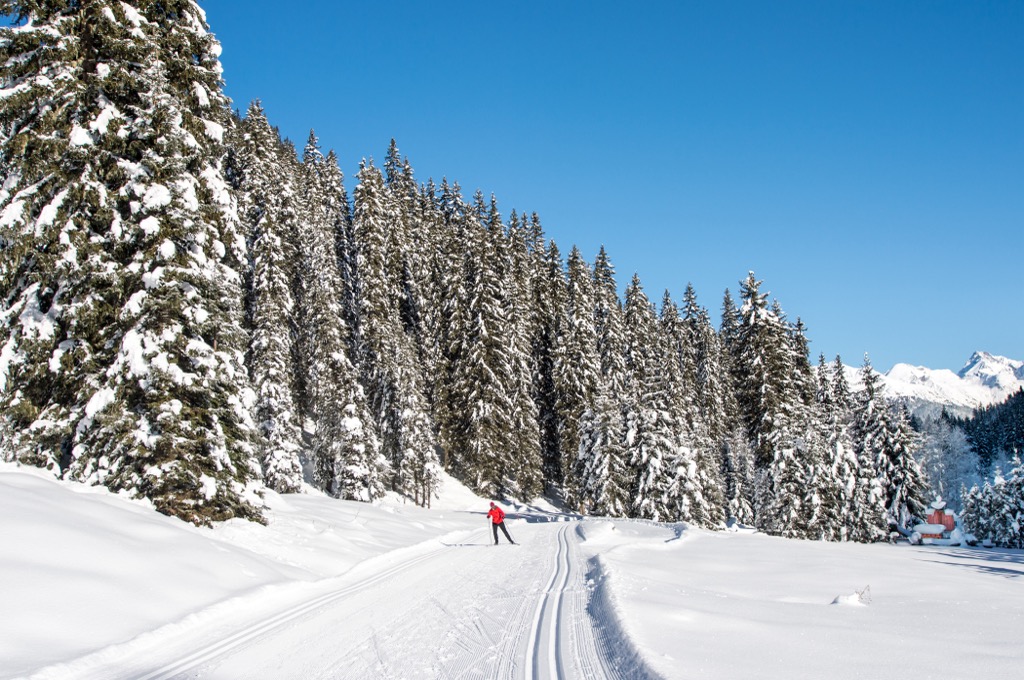
There’s tons of backcountry action to be found all around Ski Arlberg. In addition to the 200+ km (124 mi) of ski routes, there are more intense trails you won’t find on any map. The potential thrills - as well as the dangers - are greater than what you’ll find on marked runs.
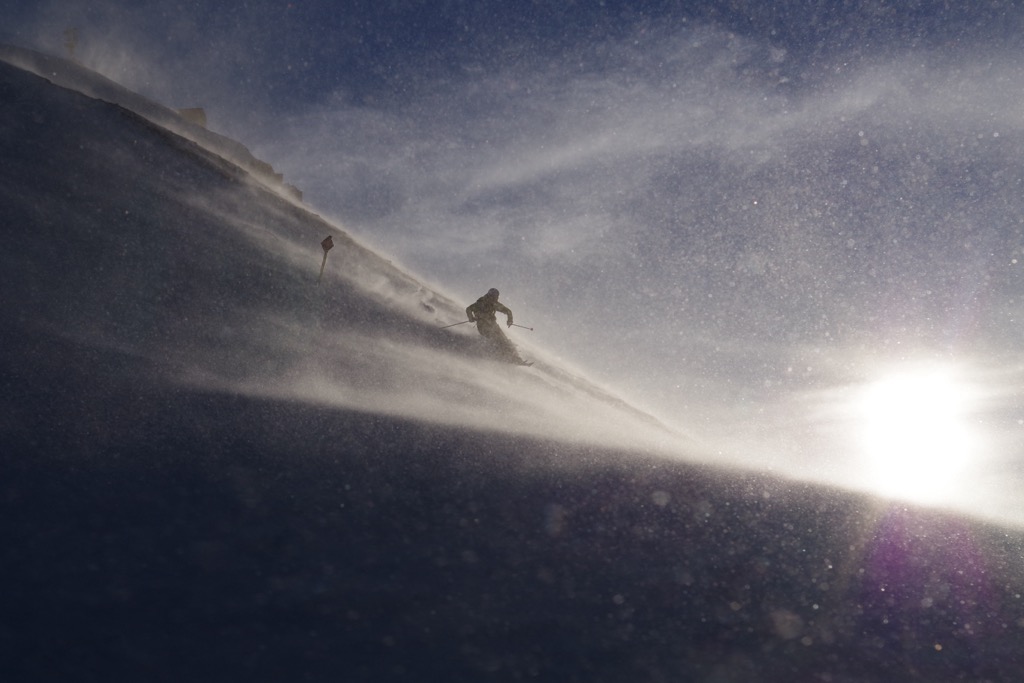
If you find yourself at the top of the Kapallbahn looking for a challenge, Schöngraben awaits. German for ‘beautiful graves,’ Schöngraben is a backcountry area that leads back down to St. Jakob (west of St. Anton). It’s a great end-of-day run if you stay in the area, but if you’re craving more, you can return to the Nasserein gondola. The area is quite avalanche-prone and should not be attempted without the proper precautions and training (though you can avoid many of its hazards by staying close to the trees).
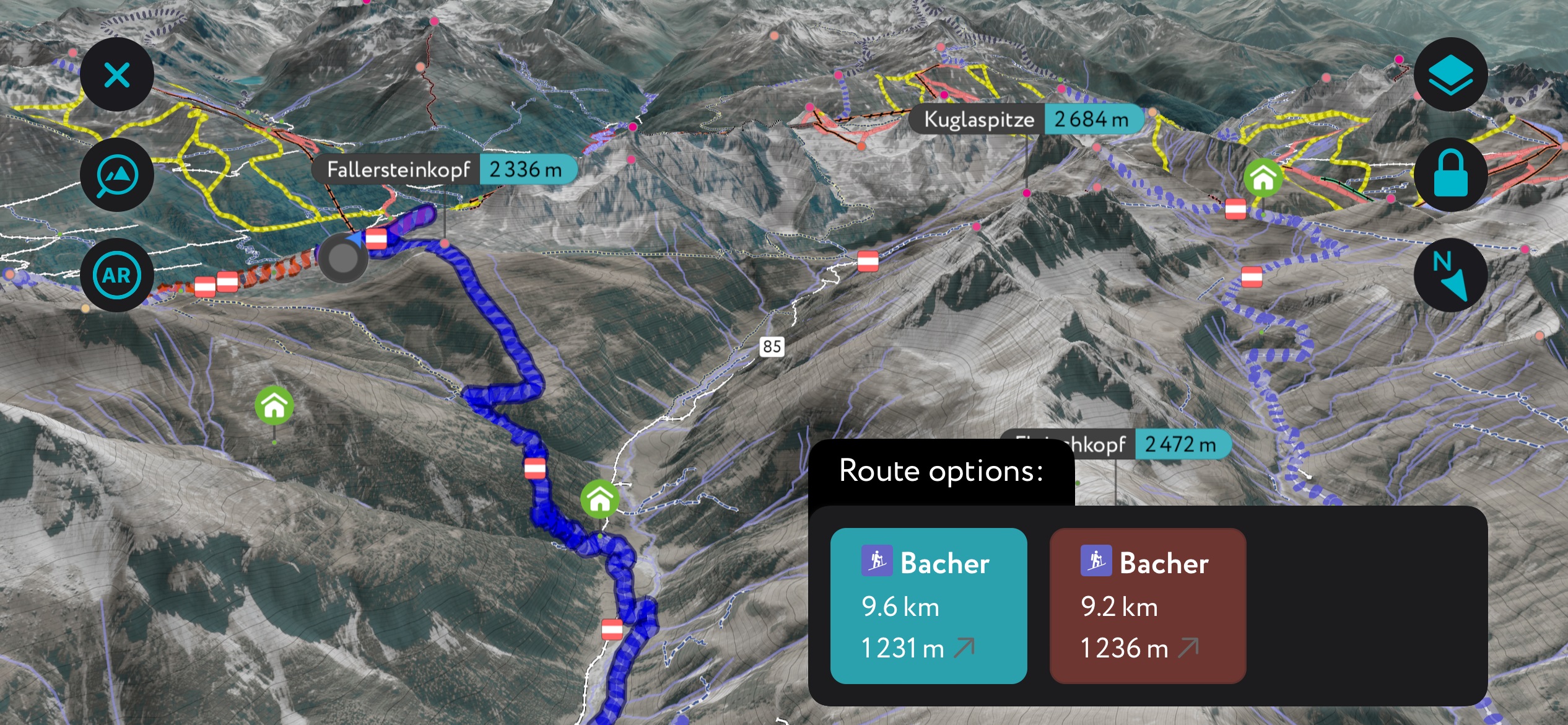
The last stop on the Vallugabahn isn’t just a great place to take in some incredible views; it’s also the starting zone for fantastic backcountry skiing. There are two main ways down to Zürs: a northern route and a western one. Both feature grueling ascents of over 200 m (656 ft) and straddle cliffs and other dangers — hence, I recommend not attempting these routes without a guide if you are not an expert off-piste skier. The western route is steeper, but both present a challenge. A vertical drop of over 1,000 m (3,281 ft) makes these some of the most coveted ski descents in the region.
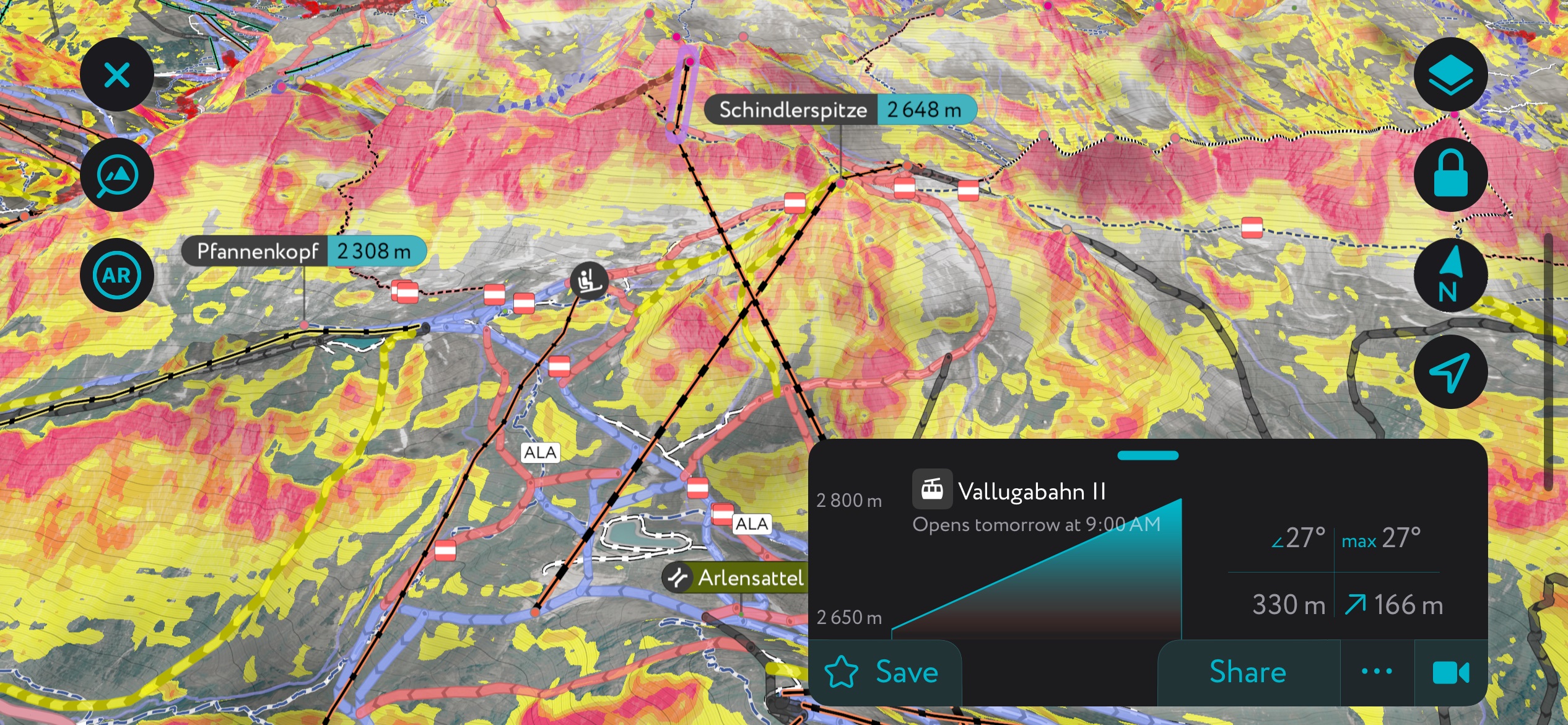
Rendl is also home to an excellent backcountry run that’s well-traveled and requires no hiking. From the top of the Riffel II chairlift, take the short walk to the ridge’s edge and see a relatively narrow bowl that runs east for a few hundred meters before turning north. Keep right to avoid the cliffs and ski down the bowl. After the route turns north, there’s a small ridge in the middle of the bowl, which you can ski to either side of (the skier’s right is easier). The steepness will have abated by now, but there’s still a long way down. Once you enter the woods, stay on the left side of the small valley, but otherwise, head straight down. Keep your eyes peeled for a small road (it’s usually pretty easy to find). Join the road as soon as you see it and head west till you reach the Rendl Talabfahrt (the piste that leads to the bottom).
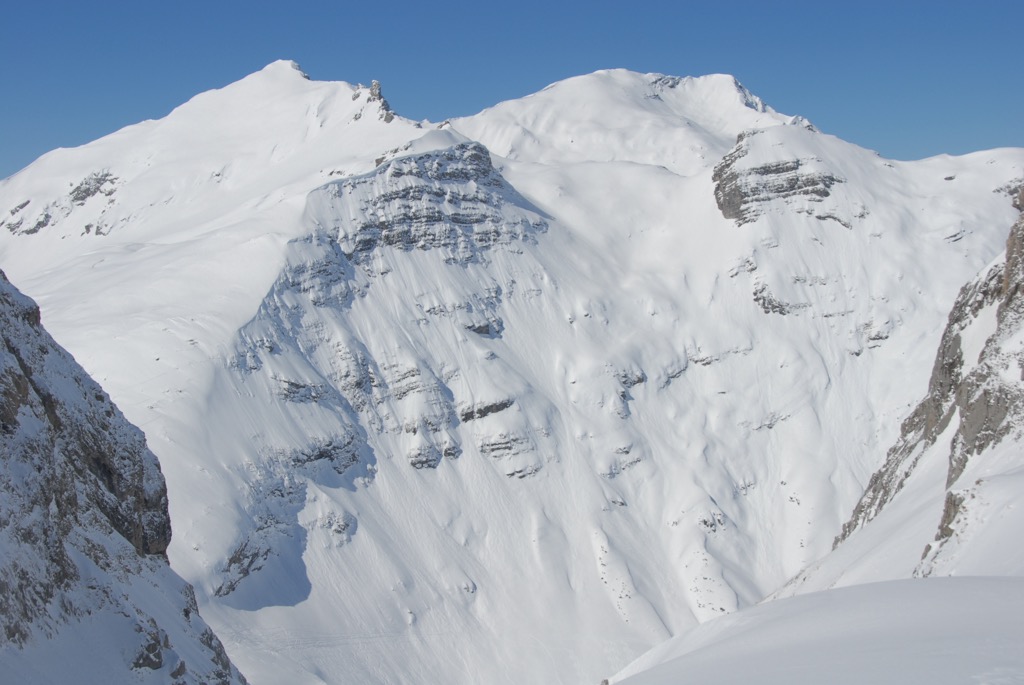
St. Anton backcountry.
There are dozens of other popular backcountry routes throughout Ski Arlberg. Most promise amazing views and epic journeys. Still, extreme caution is a must for skiers unfamiliar with the mountain. You should always know the current avalanche risk, bring appropriate equipment, and only attempt a backcountry route with a companion familiar with the area.
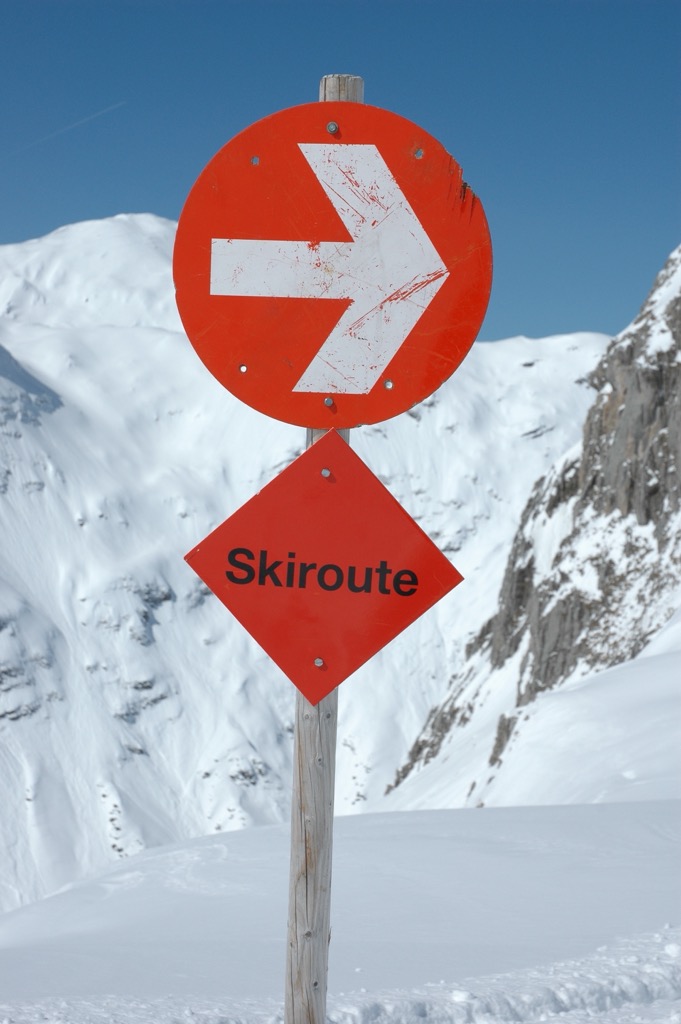
These markers will help you navigate sections of off-piste.
Season passes for Ski Arlberg are going for €1,114 during the 2023/24 ski season. Day passes cost adults €75 during the core season and €70 during the early (before Christmas) and late (April) season. Children, seniors, and others can enjoy steep discounts. Passes and day tickets grant access to all of Ski Arlberg and the Sonnekopf. When purchasing day tickets, you also get a better deal the more you buy.
It’s also possible to buy tickets granting you 15 or 30 ‘points.’ The number of points each day costs depends on when you start. Point-based tickets can be a good option if you often don’t get out till the afternoon. But if you’re out early, buying day passes is better. For example, a 15-point pass costs €357. You'll have used all your points if you start before noon each day and ski on five separate days. On the other hand, buying a set of five-day tickets costs €345.
Multiple tourism offices can provide a wealth of information about Ski Arlberg.
St. Anton
Dorfstrasse 8 extern
6580 St. Anton am Arlberg
Telephone: +43 (0) 5446 22690
E-Mail: info@stantonamarlberg.com
Lech
Dorf 2
6764 Lech
Telephone: +43 (0) 5583 21610
E-Mail: info@lech-zuers.at
Warth
HNr. 32
6767 Warth
Austria
Telephone: +43 (0) 5583 35150
E-Mail: info@warth-schroecken.com
Ski Arlberg has a wealth of dining options. Based on my experience, the local restaurants feature excellent quality, variety, and prices, especially compared to other alpine resorts.
It’s impossible to quantify exactly how many restaurants there are in the region, but my guess is well over 300. I’ve touched upon some options for on-mountain dining in the detailed discussion about each part of the ski area. I recommend an internet search for a more complete overview of the expansive dining scene throughout Ski Arlberg.
Still, I do have a few recommendations of my own. If you’ve had your fill of traditional Alpine fare, try Skiing Buddha, a Thai-fusion restaurant right outside of St. Anton’s train station. Lit by red lights and fitted with generally modern design elements, the atmosphere is a nice departure from the warm but staid design choices you see at the majority of hotels and restaurants. The food is excellent and the prices are reasonable.
That said, I do love a good Austrian meal. Dorfstuben in St. Anton’s Hotel Kristall offers great Tirolean food in a warm and traditional setting. The atmosphere is similar to what you’ll find at most on-mountain dining areas, as are the food and drink menus, which include cheesy noodles, schnitzels, and Stiegl, the local beer of choice. In the center of St. Anton’s main drag, the hotel is right across from Bar Cuba, a sports-focused bar notable for a bizarre concoction they call ‘Love Juice’.
Thony’s is another good option for Austrian food. It has an on-mountain location under the Nassereinbahn which is a great alternative to the rowdier venues under the Galzigbahn. If you’re going for dinner, the venue in town is called Thony’s Barn. It’s a bit of a walk from the center of town, but a good place to eat if you’re looking to avoid the busier elements of St. Anton’s nightlife.
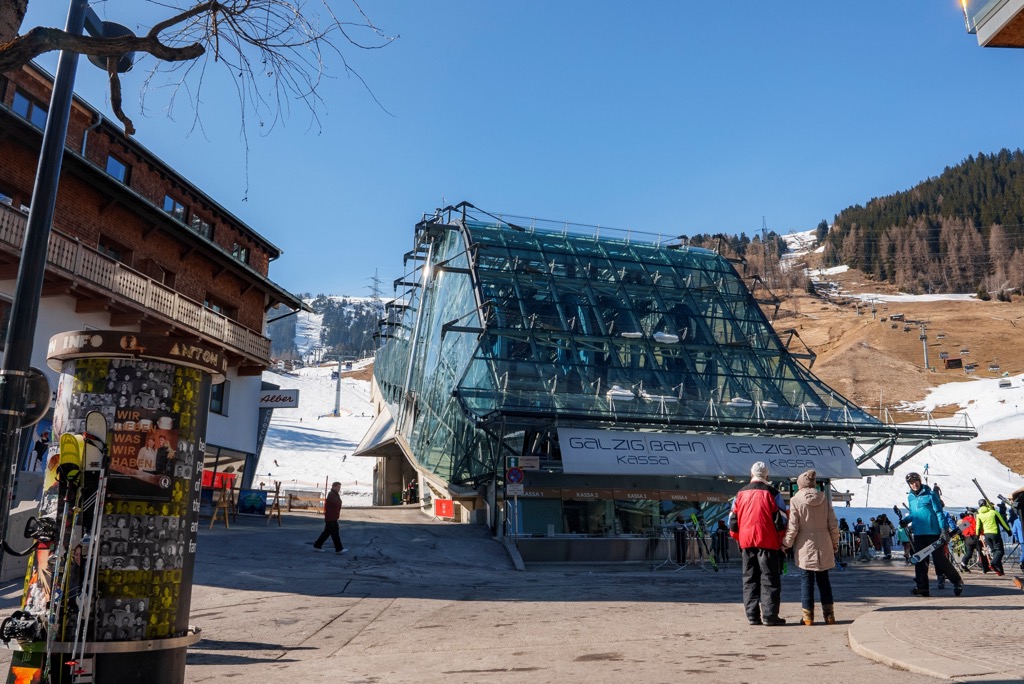
There are many options for accommodation for your trip to Ski Arlberg, but booking in advance is still a good idea. That said, if you aren’t picky and don’t plan your trip around the peak season, you’ll probably be able to find a place to stay, even if you plan a trip only a few weeks ahead.
Most rental establishments are reasonably small, taking the form of guesthouses. St. Anton, the largest village in Arlberg, has the most hotel beds. These vary quite a bit in terms of quality and expense, from a handful of hostels to high-end resorts. St. Anton has over 10,000 guest beds, while Ski Arlberg has over 15,000.
In general, Lech is home to the fanciest and most expensive accommodations. Even the smaller villages like Zug, St. Christoph, and Stubenbach have several guesthouses. As you plan your trip, consider your budget and where you’ll spend most of your time skiing. Lech is the most central village in the ski area but is also quite pricey.
Incredible terrain isn’t the only thing that draws visitors to Ski Arlberg. The resort, particularly St. Anton, is known for its legendary après ski scene. The smaller villages all have at least one drinking establishment (often in a hotel or guest house) but aren’t known for vigorous après activities.
Lech and Zürs have healthy bar scenes, with several establishments to choose from in each village. Most close between 9:00 and 10:00 pm, so late-night carousers will probably want to stay elsewhere. If you’re staying in Lech (or just find yourself thirsty while passing through in the afternoon), I recommend Hotel Tannbergerhof. The hotel has an Irish pub complete with an ice bar.
Each village has one exception to the ‘shuts relatively early’ rule: Bar Vernissage in Zürs and K-Club in Lech, two genuine nightclubs. The drinks are relatively pricey, but entry is usually free. Given that each is the only establishment of its kind in their respective villages, both can get quite crowded.
St. Anton has earned its reputation as an Alpine Mecca for après ski shenanigans. It has multiple nightclubs, dozens of bars, and a host of restaurants. Most of these are found in the village (that is, at the base), but there are also a handful of bars on the mountain's lower slopes.
These ski-in/ski-out bars fill up in the last hour or so before the lifts close and stay open long after the mountain is closed. It’s a short run down to the base from most of the ski huts, but it goes without saying that you should drink responsibly if you plan to ski down afterward. It’s not unusual to find gloves, goggles, poles, and other pieces of gear in the morning on the final stretch of piste between these bars and the base.
I’ve already mentioned Mooserwirt and Krazy Kanguruh (in business since 1965), two on-mountain drinking huts near the base of the Galzigbahn. These are the kind of establishments where people dance on tables wearing ski boots and sing loudly. I highly recommend checking the scene out, even if only for a quick peak. You’ll find Heustadl, the Sennhütte, and Restaurant Griabli in the same area. All three are more family-friendly (read: less rowdy) and traditional.
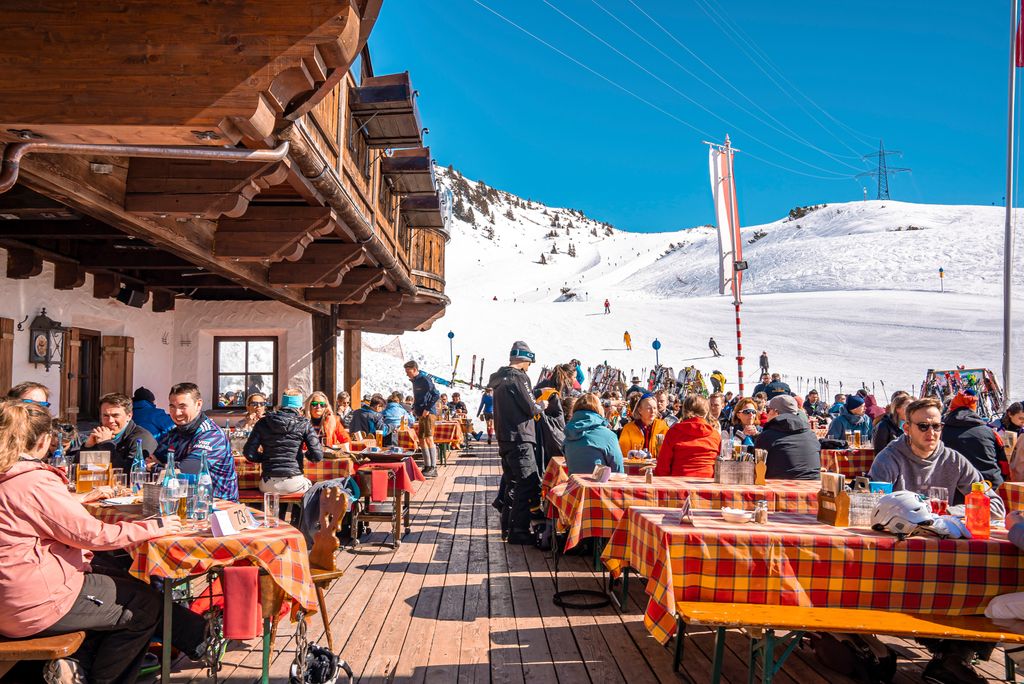
All the bars listed above have food, music, beer, and schnapps. Live or recorded, you’ll generally hear a mix of Blasmusik (the traditional brass sounds of the German-speaking world) and pop of the 1990s and early 2000s. In St. Anton and elsewhere in the Alps, these two styles have fused to form something of an eyebrow-raising synthesis.
The music is kitschy beyond belief, but it's perfect for any après scene. People sing along, dancing as best as they can in ski gear. The atmosphere of joy and wanton disregard seems a tad absurd, but it’s contagious, especially after a long day skiing and a few beers.
That said, it isn’t for everyone. Fortunately, other genres also get significant airplay, including rock, jazz, and more traditional Blasmusik (try Restaurant Griabli if you’re specifically trying to avoid the pop sounds of German ski music). In general, the sounds of St. Anton skew towards what was fashionable two (or more) decades ago, but I’d argue that this is part of the charm.
The scene at the base of St. Anton is broadly similar. There are plenty of bars, restaurants, and clubs to choose from. DJs and bands blast their tunes every night of the week, attended to by a neverending string of revelers. The parties are legendary for their debauchery.
Sadly, several of St. Anton's oldest and most beloved bars have closed in the past few years. Most have been replaced, and you wouldn’t know the town is missing anything from walking around the village at night.
Locals and regular visitors will always argue about which bars are the best in town. The truth is, this depends upon your tastes and mood. I’ll leave it to you to decide for yourself. As much as I love the scene, I also love getting in a full day of skiing, so I like to get to bed well before midnight or choose one night of my trip to let loose.
The top of the Rüfikopfbahn gondolas also marks the starting point of Der Weisse Ring (The White Ring), an iconic 22 km (14 mi) race course. The circuit over which the White Ring runs its course has been popular for many decades, but the organized race began in 2006. Since then, the annual race has attracted hundreds of competitors, skiing to win the top place in various categories.
This epic race takes place in January, covering 5 lifts, 5 pistes, 1 off-piste run, and a short ascent. All in all, this involves a total elevation change of 5,500 meters (18,045 ft). The race is challenging because of its great length — most of the terrain it crosses over isn’t anything your average experienced skier can’t handle.
The circuit sees skiers racing from the top of the Rüfibahn to the village of Zürs by ascending the Schüttboden T-bar and Trittalpbahn chair. From there, racers ride up the Seekopfbahn and Madlochbahn before descending toward Zug via Ski Route 170 (this stretch is the hardest part of the race). After riding the Zugerberg gondola and Balmengrat T-bar, it’s a long ride to the finish line via Kriegeralpe (Run 200).
On race day, the White Ring is an exciting affair that reverberates throughout Ski Arlberg. Competitors race in staggered groups, so there’s always something exciting happening. The finish line at Lech has a festive atmosphere throughout the day.
The White Ring race is Arlberg’s biggest event. Though the race takes place on a single day, the course is open all season long. Race enthusiasts should consider trying the circuit themselves. You can even time your run to see how it compares to that year’s winners.

St. Anton’s answer to The White Ring, Der Weisse Rausch (The White Thrill), is a much shorter but equally thrilling race. Taking place the day after Arlberg closes for the season, this event sees 555 contestants zip down the mountain from the top of the Vallugabahn. Given the late-season conditions, this race is far less straightforward than most popular ski races. It also includes a 150 m (492 ft) ascent, so contestants need aerobic fitness as well as downhill speed.
If you’ve ever skied at any resort on closing day, you know that the end of the season brings a festive atmosphere. The White Thrill is a post-closing day bash that sends off the bygone winter while fostering excitement for the season to come.
Hosted by Ski Club Arlberg, the STANTON Freeride gives young skiers and snowboarders a chance to test their off-piste abilities in front of a crowd of onlookers. There is a category for youths under 14 and another for U18s. Over the past few years, the event has taken place in February in St. Anton’s Rendl area.
An off-piste race, the STANTON Freeride has talented young people give it their all on the Riffelscharte, an experts-only ski route accessible via the Riffel II chairlift. Parents and fans can take in the action from the top of the Riffel I lift.